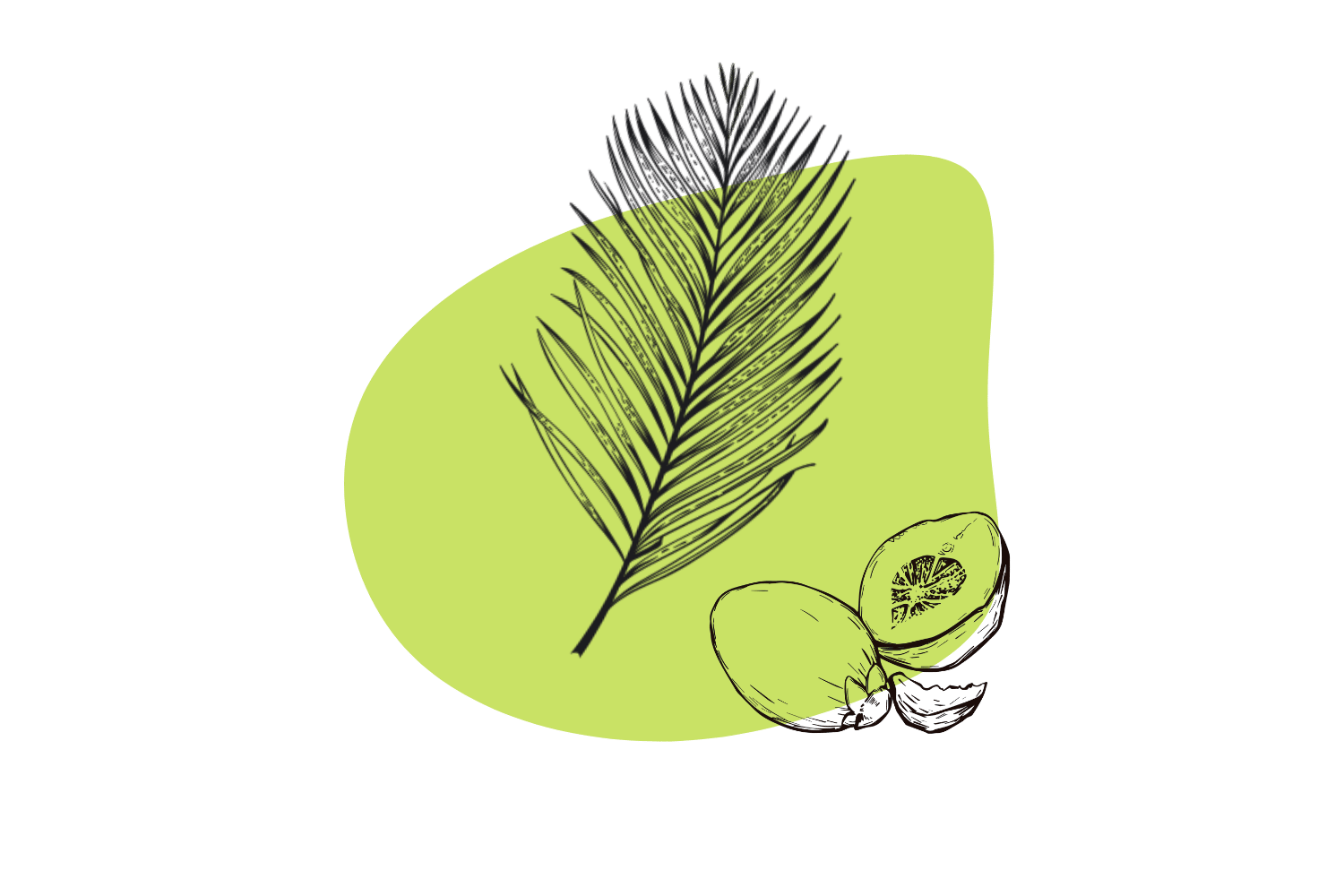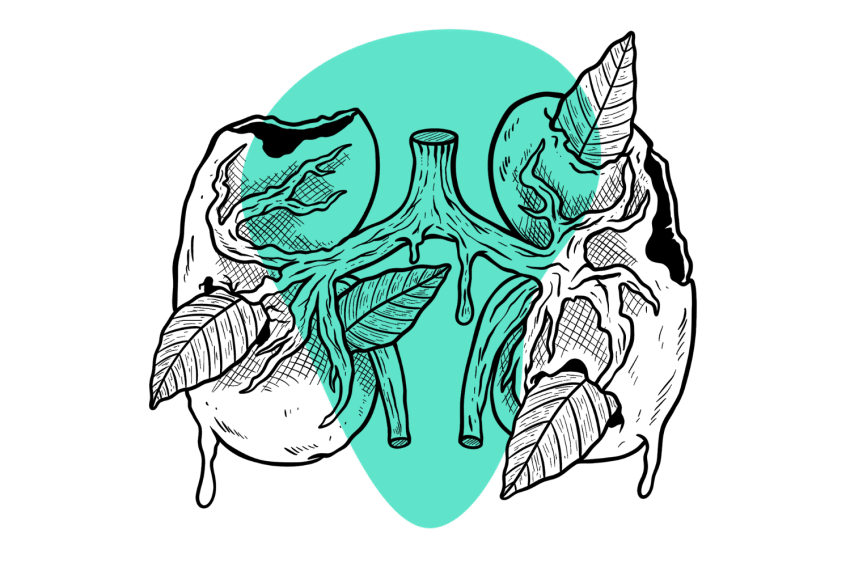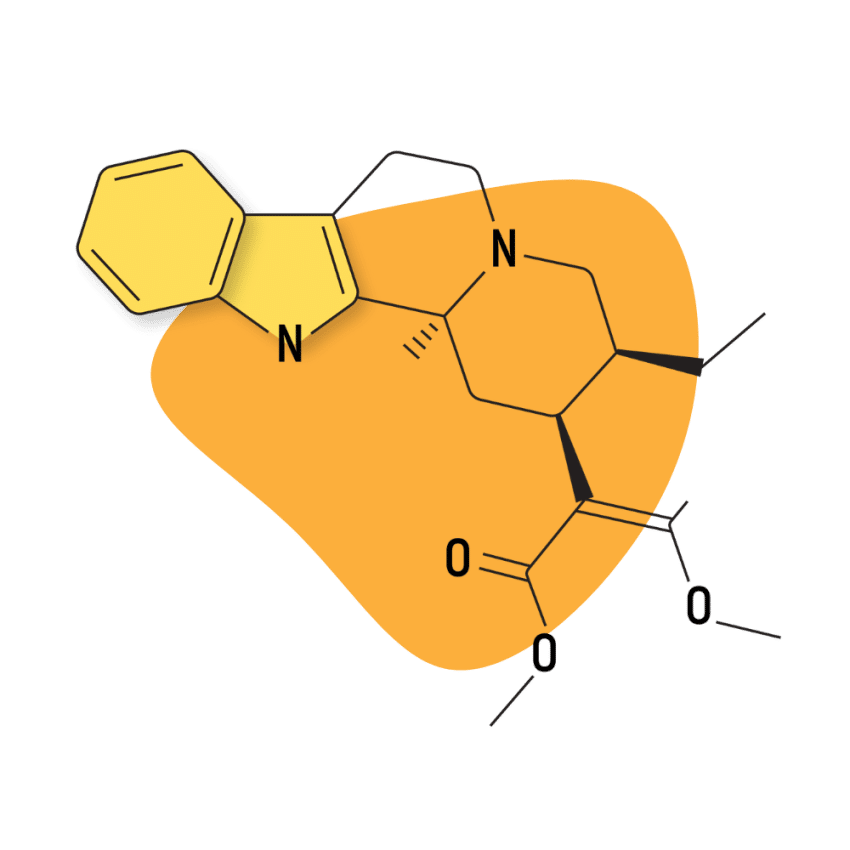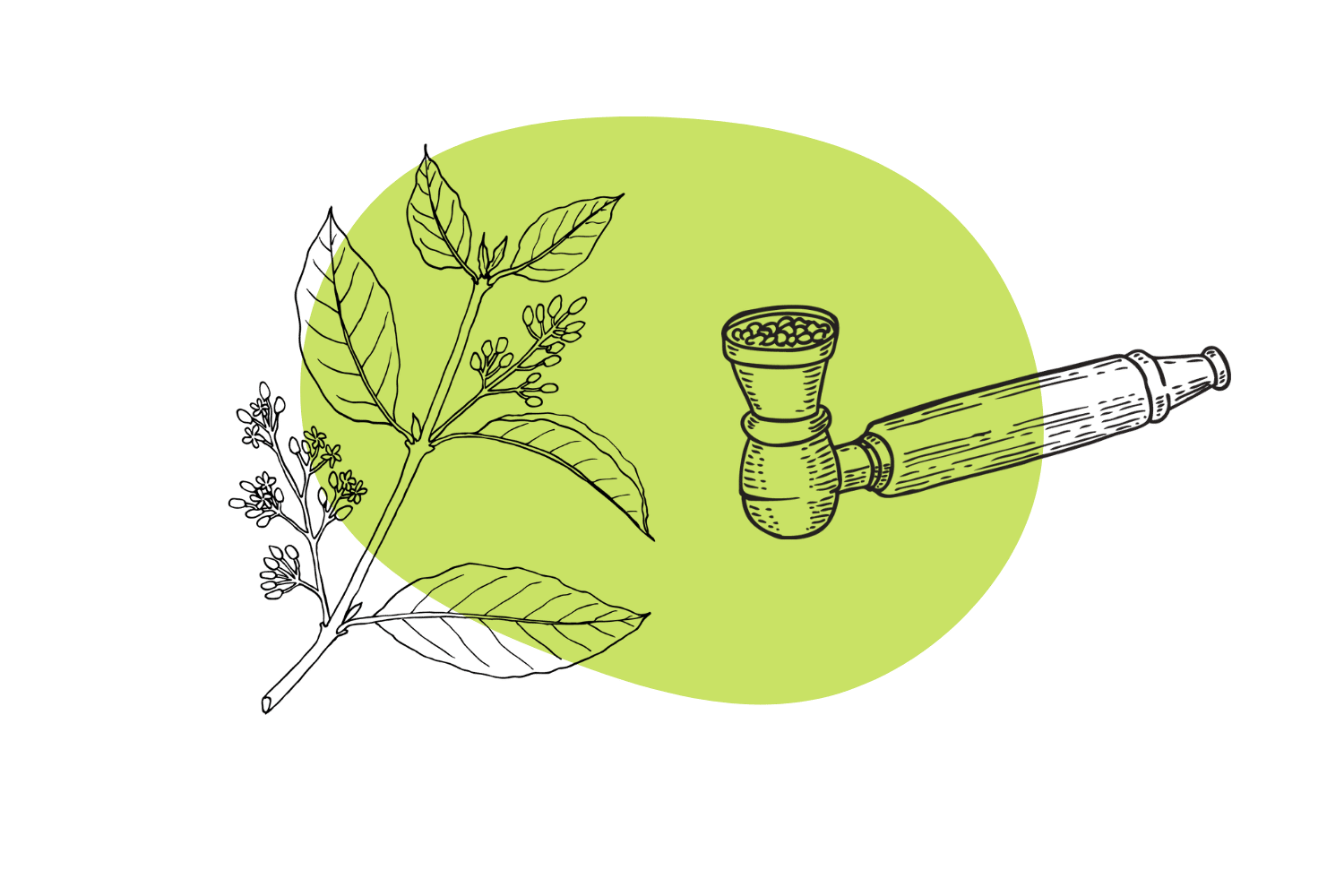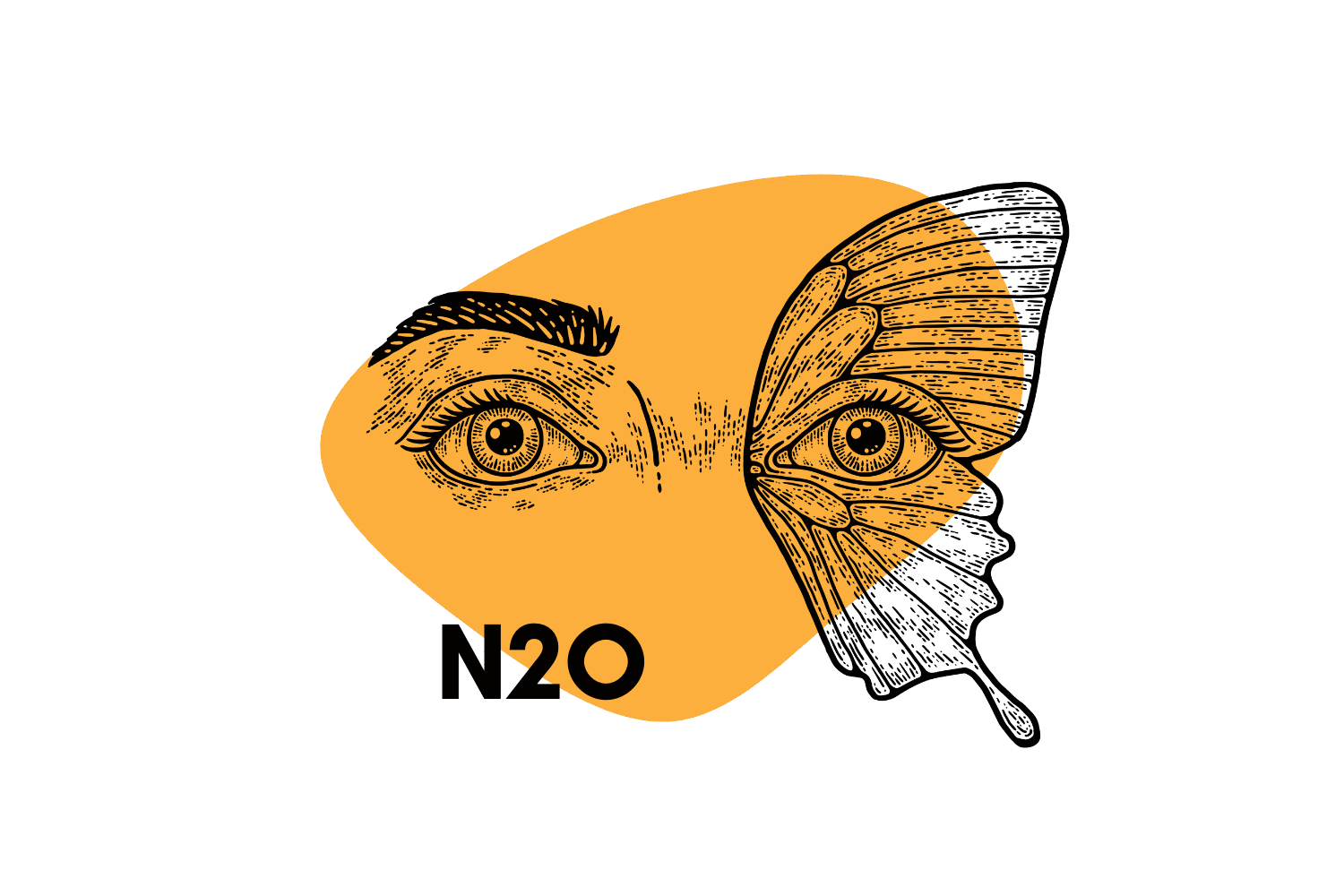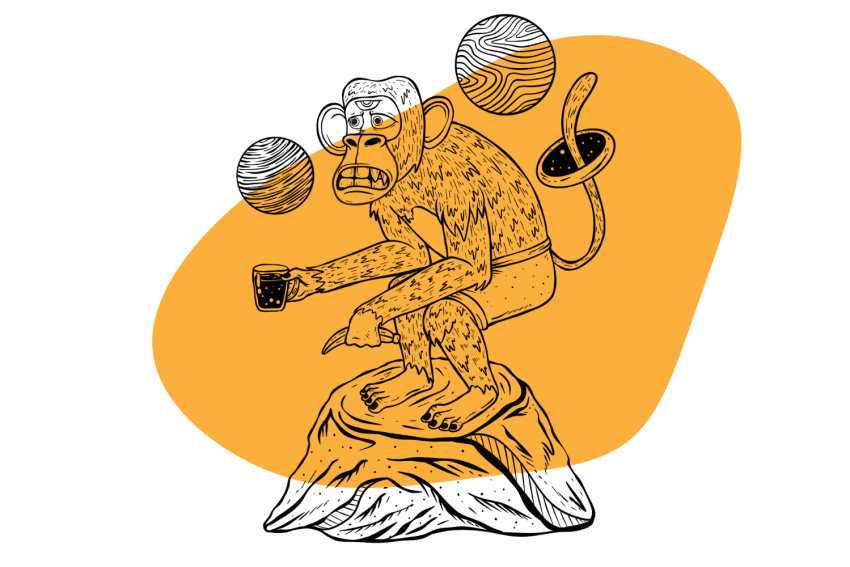What is Kratom? Is it Safe?
Kratom is a controversial plant.
Some think it should be banned because it has opiate-like effects; others argue it should remain legal as an alternative to prescription painkillers.
Like all things, it’s imperative kratom is used responsibly.
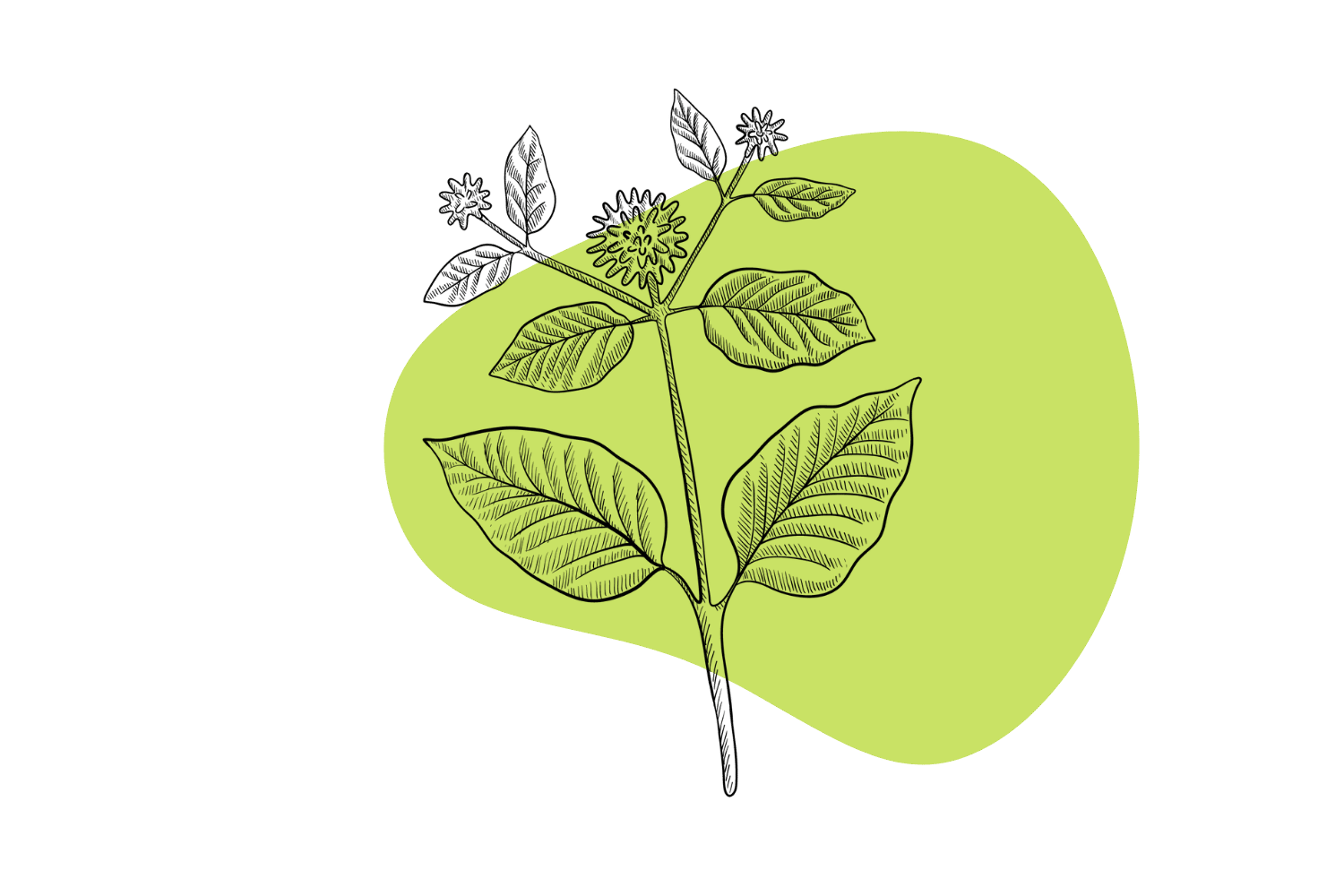
Kratom has gotten a bit of a bad reputation over the past couple of years.
The DEA refers to it as a “drug of concern” — but the plant is not explicitly illegal in the United States.
While there are concerns over kratom use — it’s not nearly as dangerous as it’s made out to be.
Kratom activates the opioid receptors, which is the same receptor many prescription pain pills and illicit drugs like heroin target as well. This has many jumping to the conclusion that if painkillers are bad, kratom must be bad too.
In this article, we’ll cover everything you need to know about kratom — including how it works, how much to use, and when you should avoid it altogether. We’ll cover the current research on this herb to show you why kratom isn’t as bad as it’s made out to be, but also what you need to know to stay safe while using it.
What is Kratom?
Kratom (Mitragyna speciosa) is a medicinal plant species from Southeast Asia. It’s a member of the coffee family (Rubiaceae). Like coffee, kratom is a central nervous system stimulant used to increase energy and productivity.
However, the effects of kratom are highly dose-dependent.
In lower doses, it’s a stimulant but in higher doses, the effects flip-flop and become sedative instead.
As a result, there are a few different reasons someone may want to use kratom.
In smaller doses, it’s used much like coffee — as a stimulant and nootropic for use at work or university.
In higher doses, kratom is used as an alternative to alcohol (not recommended) for its euphoric effects, to promote sleep, and as an alternative to opiate painkillers.
Many of the active ingredients in kratom are powerful opiate agonists — which means they bind to the opioid receptors to block the transmission of pain signals from the body to the brain. This also triggers the release of the feel-good neurotransmitter, dopamine.
People addicted to opiates use kratom to wean themselves off the drugs. The effects of kratom help alleviate withdrawal symptoms while undergoing detox for prescription or illicit opiates (more on this later).
Kratom is not particularly dangerous, but there are risks to using it. While far less addictive compared to prescription painkillers, kratom is still an opiate. Over time, the body can become dependent on its effects and become addicted.
Kratom: Specs & Technical Details
| Primary Active Ingredients | Mitragynine, specioginine |
| Level of Risk | Moderate to High |
| Common Names | Kratom, Kakuam, Ketum, Biak-biak, Ithang, Thom |
| Most Common Side Effects | Nausea, fatigue, dependency |
| Duration of Effects | 2–3 Hours |
| Legality | Legal-Grey Area |
What Are The Benefits of Kratom?
Kratom is used as a sedative to help with sleep, as a painkiller for chronic pain symptoms, and as a stimulant for boosting productivity at work or in the gym.
Kratom’s benefits change depending on whether you’re using a high dose or low dose.
Benefits of low-dose kratom:
- Increase focus and concentration
- Immune support
- As a nootropic supplement
- As a coffee replacement for combatting fatigue
- To support fibromyalgia or chronic fatigue symptoms
- To boost mood
Benefits of high-dose kratom:
- Alleviates chronic pain symptoms
- Supports arthritis symptoms
- Reduces diarrhea
- Reduces stress & anxiety symptoms
- Cough suppressant
- Supports immune function
- Promotes sleep
- Induces feelings of euphoria

What’s The Dose of Kratom?
The effects of kratom change with the dose, so it’s important to get it right.
The ideal dose for you depends on a few other factors as well:
- Your weight
- Your tolerance to the plant (the more often you use it, the higher dose you need for the same effects)
If you’re using kratom for the first time or only use it occasionally (recommended), most people find a dose of 0.04 grams per kg of body weight is sufficient for the stimulating effects.
For sedative or painkilling action, aim for a dose of around 0.06 grams per kg.
This works out to around 0.025 grams (stimulating) and 0.04 grams (sedative) per pound.
People who have a tolerance to the plant may need to tweak the dose slightly to get the same effects. It isn’t an exact science — tolerance forms differently in everybody.
The most common form of kratom is the dried powdered leaf — which is best measured in grams. You can also measure the leaf in tablespoons, but this is less accurate because kratom leaf that has a fine grind will weigh more than a leaf with a coarser grind despite taking up the same amount of volume.
Imperial To Metric Conversions
| Metric Weight | Imperial Volume |
| 2.5 Grams | 1 Teaspoon |
| 7 Grams | 1 Tablespoon |
Kratom Dosage Based on Weight
| Weight in Lbs | Weight in Kg | Dose of Kratom For Energy | Dose of Kratom For Pain & Sleep |
| 80 lbs | 36 kg | 2.0 grams | 3.5 grams |
| 100 lbs | 45 kg | 2.5 grams | 4.0 grams |
| 120 lbs | 55 kg | 3.0 grams | 5.0 grams |
| 140 lbs | 65 kg | 3.5 grams | 5.5 grams |
| 160 lbs | 72 kg | 4.0 grams | 5.5 grams |
| 180 lbs | 82 kg | 4.5 grams | 6.5 grams |
| 200 lbs | 90 kg | 5.0 grams | 8.0 grams |
| 220 lbs | 100 kg | 5.5 grams | 9.0 grams* |
| 240 lbs | 108 kg | 6.0 grams | 9.5 grams* |
| 260 lbs | 118 kg | 6.5 grams | 10.5 grams* |
| 280 lbs | 127 kg | 7.0 grams | 11.0 grams* |
| 300 lbs | 136 kg | 7.5 grams | 12.0 grams* |
Kratom Dose for Energy
If using kratom for its nootropic and stimulating effects, the usual dose is between 2 and 8 grams of dried, powdered leaf, depending on your weight.
This dose is easily achieved taking capsules. The lower dose means you don’t need to take too many capsules at once. It usually works out to around 2 or 4 capsules.
You can also use the toss and wash method if you’re using raw powder.
The effects usually take about 20 to 40 minutes to kick in and last for about 2 or 3 hours.
Avoid taking a second dose until the first one is mostly worn off to avoid crossing over into the sedative effects — which would be counter-intuitive to using kratom for the purpose of increasing energy and focus.
What This Dose Feels Like
Lower doses of kratom are rarely psychoactive in any way. It feels similar to drinking coffee but with less anxious side effects.
Kratom increases both mental and physical energy. While working or studying, you may find your focus becomes sharper, and it becomes much easier to enter flow states.
If on the move, say at the gym, on a run, or doing some yard work, you’ll likely find you’re more enthusiastic with your movement and can perform your tasks for a longer period of time before tiring out.
This dose still provides some pain relief but may not be enough for anything more than mild pain. Many people with mild arthritis or back pain note improvements while doing yard work or manual labor, even with smaller doses of kratom.
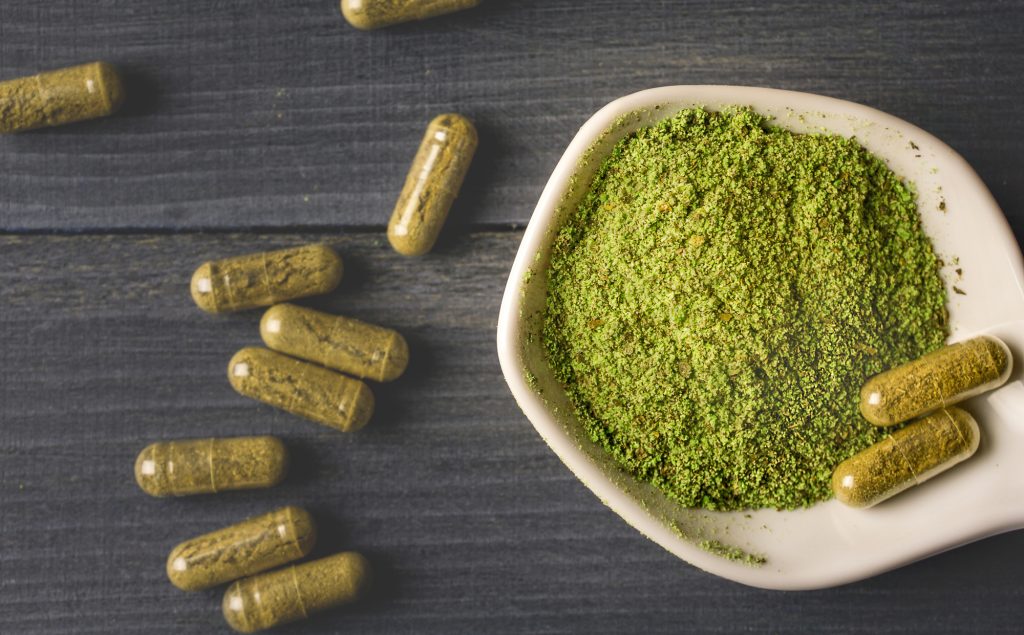
Kratom Dose for Pain & Sleep Support
The opioid-like effects of kratom only start to take effect in the higher dosage range of around 0.12 grams per kilogram (0.06 grams per pound). This works out to around 5 to 16 grams for most people.
This higher dose can be achieved through capsules, but you’ll need to take several at a time. Single 00 capsules only hold about 600 milligrams of kratom, so you may need to take more than ten capsules at a time. It’s much easier to use the toss and wash method for doses this large.
What This Dose Feels Like
Higher doses of kratom become mildly psychoactive. You’ll likely feel bouts of euphoria and relaxation. People often feel like they’re “floating.”
The initial effects tend to be more stimulating in nature but quickly become more relaxed and sedating.
As the kratom kicks in, pain symptoms also start to diminish.
The effects usually peak around the 2-hour mark and can sustain for another 2 or 3 hours. It can make you feel very social and talkative without being overstimulated or energetic.
Some people find it forces them to sleep — others don’t feel sedated but can get to sleep more easily due to feeling more relaxed and less anxious.
Is Kratom Dangerous? What You Should Know
There’s a lot of controversy around the use of kratom.
This controversy primarily stems from its effects on opiate receptors. This is the same pathway prescription and illicit opiate painkiller work through — leading many to jump to the conclusion that kratom has all the same risks as these powerful synthetic chemicals.
While kratom does activate the opioid receptors — it isn’t nearly as dangerous or addictive as its pharmaceutical counterparts.
Kratom overdose is very different from overdoses on prescription pain meds or illicit drugs like heroin. When you take too much kratom, you’ll experience a series of symptoms referred to as the “kratom wobble” (more on this in the next section).
There have been some reported deaths from using kratom — but this is extremely rare and almost always involves mixing other drugs or alcohol. It’s not safe to mix kratom with alcohol or other illicit or prescription drugs — especially other opiates.
An older study exploring the toxic dose of kratom found that even very high doses of mitragynine (920 mg/kg) didn’t have any lethal side effects [4]. To put this into context, this would be the equivalent of using roughly 62 grams of kratom leaf for an average 150 lb person. This is nearly impossible for anybody to consume in one sitting. You would start to feel the uncomfortable kratom wobble side effects long before you ever reach a toxic dose.
What is the Kratom Wobble?
There’s a classic set of symptoms people often experience after using too much kratom. Symptoms involve a combination of dizziness and loss of coordination. It’s aptly referred to as the “kratom wobble” because everything looks and feels wobbly.
The symptoms of the kratom wobble include:
- Dizziness
- Blurry vision
- Nausea & vomiting
Many users report feeling like the room is spinning and may find it difficult to move around or do much of anything.
This side effect is uncomfortable but acts as an important safety mechanism when using kratom. The effects of the kratom wobble prevent people from ever reaching lethal doses. Once these effects start to appear, it’s very unlikely for you to want to take any more.
The kratom wobble is, by far, the most common side effect of taking too much kratom. It’s so common; there’s a universal rating system for kratom strains called “the wobble threshold” — which refers to the likelihood a particular strain of kratom stands for producing these effects.
The lower the wobble threshold, the more likely a strain is at causing these side effects.
What to do if you experience the kratom wobble:
- Find a quiet place to lay down and relax
- If you’re feeling anxious, put on some gentle music and focus on slow and rhythmic breathing
- Drink some ginger tea or warm water (avoid any caffeinated teas)
Remember to reduce the dose of kratom the next time you use it to avoid having these side effects again or consider finding a strain of kratom with a higher wobble threshold.
Side Effects of Kratom
Aside from the kratom wobble, there are other potential side effects of using the plant. We can break these side effects into two different categories depending on which system is involved.
Kratom targets both the adrenergic system (involved with the fight or flight) and the opioid system (involved with pain transmission and the reward pathway). The side effects that can result from interaction with these systems can seem contradictory at times, so we’ve decided to split them into separate groups.
Adrenergic Side Effects:
- Anxiety
- Diarrhea
- Dizziness
- Dry mouth
- Headaches
- Increased urination
- Insomnia
- Irritability
- Nausea
- Rapid heartbeat
- Stimulation
- Sweating
Opioid Side Effects:
- Constipation
- Dizziness
- Euphoria
- Increased urination
- Itchy nose
- Lethargy
- Nausea or vomiting
- Sedation
Is Kratom Addictive?
The short answer to this is yes — kratom can become both physically and behaviorally addictive with long-term use.
The potential for addiction is one of the main concerns people have about using kratom.
Addiction is not a disease — it’s a physiological and psychological attempt to find release from the discomforts of life. When we use a substance (or activity) to cope with pain, discomfort, or sadness, we may become reliant on these substances to feel this way.
Kratom improves mood, enhances focus, and alleviates pain — which gives it ample potential to become addictive in people suffering from any of these problems. This is called behavioral addiction — which means we’re addicted to the effects of the substance.
Over long periods of time, kratom can also become physically addictive — which means the body adjusts to the effects of plants in such a way that without it we’re unable to maintain balance. When the effects wear off, it can cause withdrawal symptoms that make the body seek another dose of the drug.
Kratom Addiction vs. Prescription Opiate Addiction
Kratom is addictive — but it’s far less physically addictive than pharmaceutical opiates.
When we become addicted to opiates, what’s happening is that the body is adjusting the opiate receptors to counteract the effects of the substance. The stronger the substance acts on the opiate receptors, the faster the body makes these changes — leading to addiction.
Kratom has a much weaker effect on opiate receptors than prescription drugs.
In fact, kratom is often used as a treatment for prescription opiate addiction because it can help alleviate the side effects of withdrawal while being significantly less addictive than pharmaceutical opiates overall.
The idea is that people addicted to opiates slowly transition from using prescription or illicit drugs to using kratom. They can then quit the kratom much more easily.
Opiate addiction has become a global pandemic over the last 20 or 30 years. According to a report published in 2020, an estimated 16 million individuals around the world have had or are currently suffering from opioid addiction disorders [3]. Roughly 500,000 people in the US alone are currently addicted to heroin, and many thousands more are addicted to prescription painkillers.
What Makes Opiate Drugs So Addictive?
Opioid drugs push one button, and they do so with a lot of force. The button they press is the opioid receptors — which are involved with blocking the transmission of pain and regulating the dopamine-reward pathway in the brain. When the opiate receptors are activated, it stops pain signals from reaching the brain and causes the release of dopamine — which gives us a quick hit of euphoria.
The dopamine-reward system deserves a whole article on its own and is extremely complicated. But the basic function of this system is to create positive reinforcement from doing things that benefit the body — such as eating, exercising, or having sex.
By releasing dopamine to trigger the experience of euphoria (pleasure) as a reward, it makes us want to perform the action that caused this effect again.
Unfortunately, opiates trigger this effect even though they don’t directly benefit us. It makes us want to use these drugs again and again to get another hit of dopamine.
Interestingly, all addiction works through this effect — including non-substance addictions such as sex, gambling, shopping, porn, or video-game addiction.
Opiate drugs form addiction much more quickly because they work directly on the reward pathway.
When we’re physically addicted to opiates, we feel ill when the drugs wear off — prompting us to use more of the drug just to feel normal again.
What’s happening here is that the drug is causing a force on the opiate receptors that pushes it beyond the normal balance. The body doesn’t like being out of balance (even if it feels good), so it makes adjustments to counteract the drug. These adjustments usually mean hiding some of the receptors. We then need to take more of the drugs to achieve the same effect.
Think of this like using the tare function on a scale.
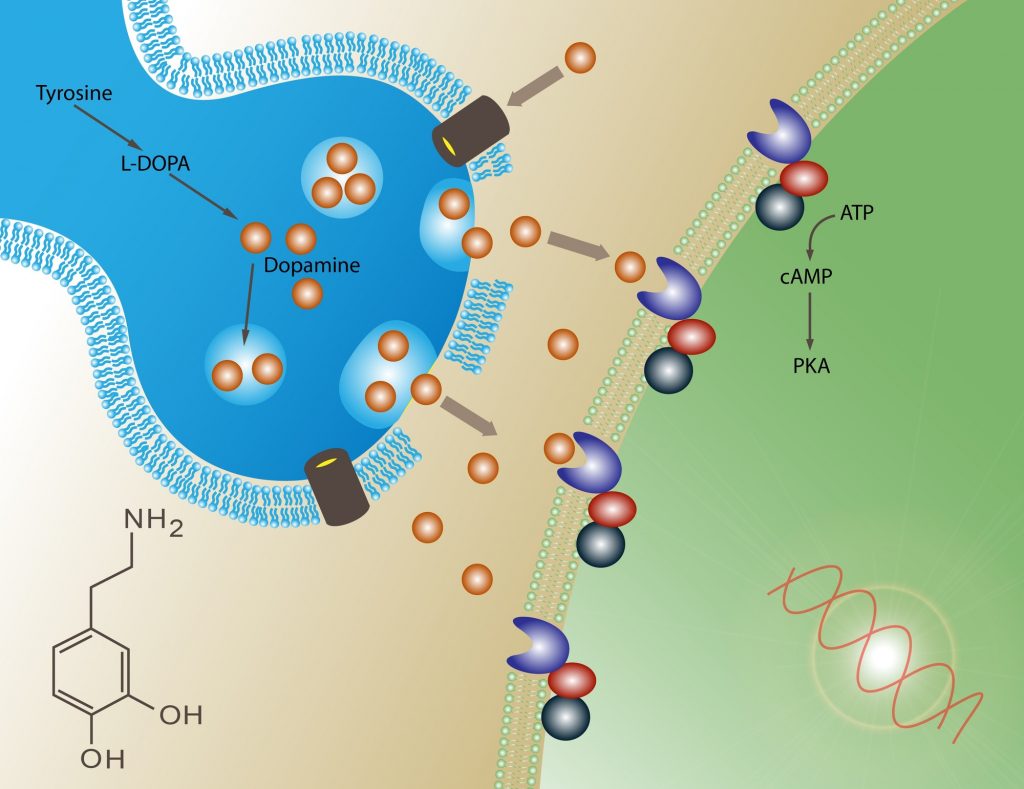
When we place some force on the scale, it adds weight. The body wants to be at 0.00 (balanced), so this added weight is considered an “imbalance.” To correct it, the body uses the “tare button” to counteract the force — bringing us back to 0.00.
If the weight is removed (aka, the drug wears off), the scale shows a negative number — which means it’s out of balance in the other direction.
This imbalance is what causes withdrawal symptoms.
How Kratom Can Lead to Addiction
Kratom can also lead to dependence and addiction in a similar way as opiate drugs — but it takes a much longer amount of time and tends to be much less severe.
Unlike prescription opiates like fentanyl, morphine, codeine, or oxycodone — kratom has less force on the opioid receptors. This means the body doesn’t need to adjust itself as much.
In order to become physically addicted to kratom, we need to use it regularly for a much longer period of time compared to prescription painkillers.
Additionally, kratom exerts its effects through several other pathways in the body — rather than relying solely on the opioid receptors.
Instead of forming dependency and tolerance in just a few weeks, it can take several months of consistent kratom use before it leads to dependency and addiction.
Signs of Kratom Addiction
The signs of kratom addiction are very similar to other opiate medications.
Here are some basic signs you may be addicted:
- You require a very high dose of kratom to feel the desired effects
- You feel physically ill when you’re not using kratom
- You constantly think about using kratom
- You’ve lost motivation for other responsibilities such as work, school, or housework
- You’ve become isolated from friends or family
The physical signs of withdrawal can include muscle pain, diarrhea, vomiting, anxiety, rapid heart rate, fatigue, insomnia, or muscle tremors.
What To Do If You’re Addicted to Kratom
Treating kratom addiction follows the same philosophy as any other addiction. It involves gradually weaning yourself off the drug. This process is referred to as detoxing.
Weaning off any opiate you’ve formed a dependency on is inherently uncomfortable. You’re essentially going to feel mild to moderate withdrawal symptoms for a couple of weeks until your body can adjust to not having the drug in the system anymore.
The process works the same way as the addiction formed in the first place, only in reverse.
Once you stop taking the herb, the body will start to “unhide” the opiate receptors to achieve balance once again.
Fortunately, treating kratom addiction is significantly easier than prescription pain pills or heroin — but that doesn’t mean it’s easy. It requires discipline and motivation.
You’ll be constantly fighting the urge to use more kratom as you go through the detox. But just know that these feelings are only temporary. As long as you stick to the detox regimen, these cravings and the uncomfortable side effects will gradually start to fade away completely.
It’s possible to treat kratom addiction at home yourself with the right motivation. It helps to have family or friends for the first couple of days to help you through the most challenging part of the detox.
If you find it difficult to break through the first few days of treatment, you can visit a detox or rehab center to help you through it.
Kratom addiction can be treated in as little as two weeks, but many people stretch it out to 4 weeks.
The idea is that instead of quitting completely right off the bat, you gradually reduce each dose over time and work your way towards zero. This reduces the severity of withdrawal symptoms but stretches the detox out over a longer period of time.
Fix The Underlying Cause Of the Addiction
There’s always a reason why you became addicted to something — including kratom.
Addiction stems from the desire to feel happy, healthy, and free from pain and suffering. The substances we become addicted to often provide temporary relief from these feelings.
In order to remain free from addiction once the detox process is over, we have to identify the cause of our pain and learn ways to manage it without the use of substances.
The Different Kinds of Kratom
All kratom comes from the same species of plant (Mitragyna speciosa). However, there are many different strains of kratom available.
A strain describes plants that are within the same species but have different epigenetic qualities. This means they have the same genetic makeup, but there are differences in the way these genes are expressed.
Some kratom makes higher concentrations of stimulating alkaloids; others are more sedative.
There are dozens of different strains of kratom — but we can classify them under one of three main categories based on the color of the leaf veins.

1. Red Vein Kratom
Red vein kratom is considered to have the fastest onset of effects and is generally more sedative than the other types of kratom.
The red vein kratom strains have a higher concentration of 7-hydroxymitragynine overall.
Red vein kratom strains:
- Red Asia Kratom
- Red Bali Kratom
- Red Borneo Kratom
- Red Dragon Kratom
- Red Elephant Kratom
- Red Horn Kratom
- Red Hulu Kratom
- Red Indo Kratom
- Red Jongkong Kratom
- Red Kali Kratom
- Red Malay Kratom
- Red Sumatra Kratom
- Red Thai Kratom

2. White Vein Kratom
In contrast to red vein kratom, white vein strains have a much lower concentration of 7-hydroxymitragynine. As a result, they tend to be a little more stimulating and are preferred by people looking for the energizing or nootropic effects of kratom.
White vein strains also tend to be the mildest in terms of side effects and are better for daily use.
White vein kratom strains:
- White Bali Kratom
- White Borneo Kratom
- White Dragon Kratom
- White Elephant Kratom
- White Horn Kratom
- White Indo Kratom
- White Jongkong Kratom
- White Maeng Da Kratom
- White Malay Kratom
- White Sumatra Kratom
- White Thai Kratom
- White Vein Kratom

3. Green Vein Kratom
Green vein kratom can be thought of as balanced kratom. These strains are usually somewhere between the sedative red vein and stimulating white vein. They’re a great all-around option for pain, sleep, focus, and mood.
The effects of green vein kratom strains are much less predictable in their effects — some are much more sedative, others more stimulating.
Green vein kratom strains:
- Green Bali Kratom
- Green Borneo Kratom
- Green Dragon Kratom
- Green Horn Kratom
- Green Hulu Kratom
- Green Indo Kratom
- Green Kali Kratom
- Green Maeng Da Kratom
- Green Malay Kratom
- Green Sumatra Kratom
- Green Thai Kratom
- Green Vein Kratom
- Green Vietnam Kratom
- Super Green Malay Kratom

Kratom Leaf Powder, Capsules, Tinctures, & Resin Extracts
Kratom is available in many different formats. Most people who use kratom will use the raw, powdered leaf. You can mix it in with water (similar to making matcha) or follow the “toss and wash” method of swallowing the raw powder in one gulp and following it up with some water or another liquid to wash it down.
Kratom has a horrible taste — it’s bitter and chalky — so many people will seek out other forms of using this herb instead.
Capsules and tinctures are good options but require larger doses to provide the same level of benefit.
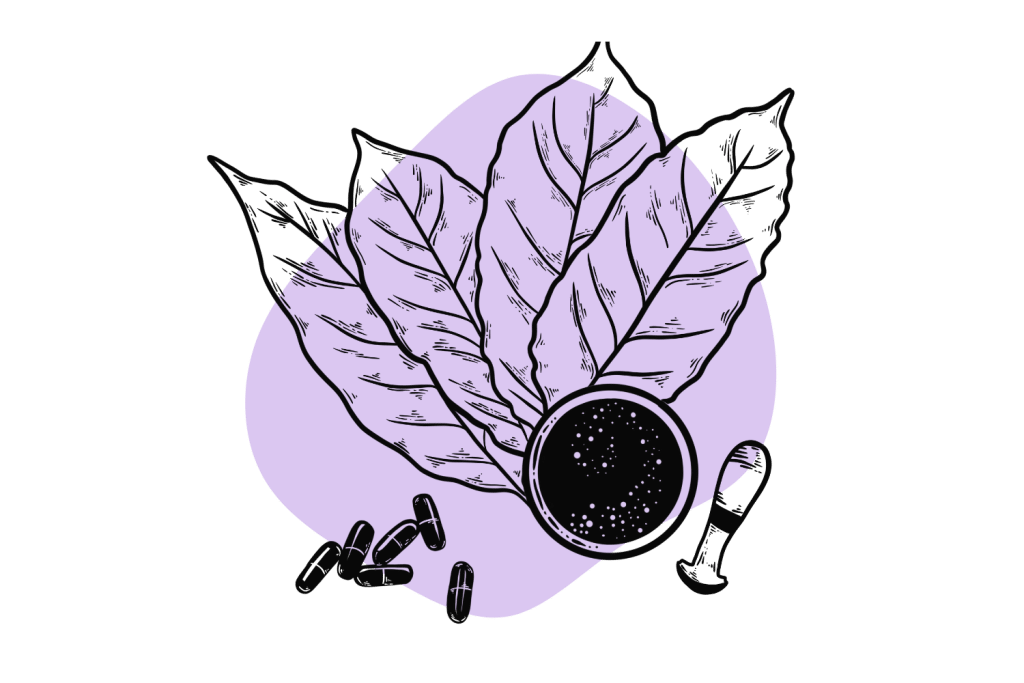
1. Kratom Leaf Powder
Using the dried, powdered kratom leaf is the most preferred method. It’s a simple and effective way to consume larger doses.
The downside is that kratom leaf powder doesn’t taste very good. Most people follow a method called the “toss and wash,” — which involves swallowing a quick dose of the powder, followed up with some water or another beverage to wash it down.
This method is like ripping off a bandaid — it’s uncomfortable, but doing it quickly means it only takes a second.
You can also mix the kratom leaf into the water and drink it that way. Some people add maple syrup, honey, or another sweetener to cut out some of the bitterness. It also helps to mix the kratom with water and leave it in the fridge for a while to make it nice and cold. This does a great job of cutting the taste of the mixture.
2. Kratom Capsules
Kratom capsules are popular because you don’t have to suffer through its bitter taste.
The only problem with capsules is that you generally need to take quite a few to get the dose. Capsules are much better for people looking for the energizing effects of the plant — which require much lower doses.
If you’re using kratom for pain or to get the sedative effect, you’ll need to take several capsules at a time.
You can buy kratom capsules premade or mix your own at home using a capsule machine.
3. Kratom Tinctures
A tincture is a liquid extract of a herb. Virtually all herbs can be made into a tincture using alcohol, water, glycerine, or oil as a base.
Tinctures are easy to use, are rapidly absorbed, and have a long shelf-life.
Avoid tinctures with alcohol as a base. Kratom and alcohol are not safe to take together. Instead, look for tinctures that use vegetable glycerine as the base. The mildly sweet flavor of glycerine has the added benefit of cutting out much of the bitterness of the kratom as well.
4. Kratom Resin Extracts
Resin extracts are like the jet fuel of the kratom world. They’re made by extracting and concentrating the pure alkaloid-rich resin in the leaves.
These products are very strong, so only those with a lot of experience with kratom should dabble in their use.
Some people prefer resin extracts because of their potency. You need a much smaller dose to get the same level of effects.
However, as a trade-off, resin extracts have a slightly different effect profile. I’d consider them to even be a little bit lacking in their effects. Some of the complementary compounds present in the leaves are removed from a resin extract, which makes them more likely to result in side effects and, in my opinion, strips away some of the herb’s beneficial effects.
Is Kratom Legal?
Kratom laws don’t always make a lot of sense. Some countries outright ban kratom as a Schedule I drug (punishable with large fines or jail time); other countries don’t regulate it at all.
There are some laws that position kratom as part of the problem of opiate addiction — others position it as a solution.
Most countries allow the sale of kratom, but there are exceptions — so make sure you’re familiar with your local laws before you place an order.
Is Kratom Legal In The United States
Kratom is legal in the United States on a federal level, but there are some states and municipalities that have independently banned the sale of kratom locally.
The DEA considered moving kratom to the Schedule I status in 2016 — which would place it among the ranks of substances such as heroin, cocaine, and LSD. However, before the ruling was made, the DEA withdrew their motion. It’s officially listed as a “drug of concern” but remains legal federally in the United States.
States Where Kratom is Banned
- Alabama
- Arkansas
- Indiana
- New Hampshire
- Tennessee
- Wisconsin
US Municipalities Where Kratom is Banned
- San Diego, California
- Sarasota County, Florida
- Jerseyville, Illinois
Is Kratom Legal in Europe
Kratom laws vary widely in Europe — some countries consider it a useful herb for reducing the societal burden of opioid addiction; others ban it in fear of contributing to the addiction epidemic instead.
European Countries Where Kratom is Banned
- Denmark
- Finland
- Ireland
- Italy
- Latvia
- Lithuania
- Poland
- Romania
- Russia
- Sweden
- Turkey
- United Kingdom
Is Kratom Legal in Asia & Australia
Some of the countries where kratom originates have outright banned the sale, possession, and use of the plant. There’s a lot of conspiracy around this that suggests the pharmaceutical companies that manufacture opioid medications lobbied local governments in the 1940s because the plant was a direct competitor with their products.
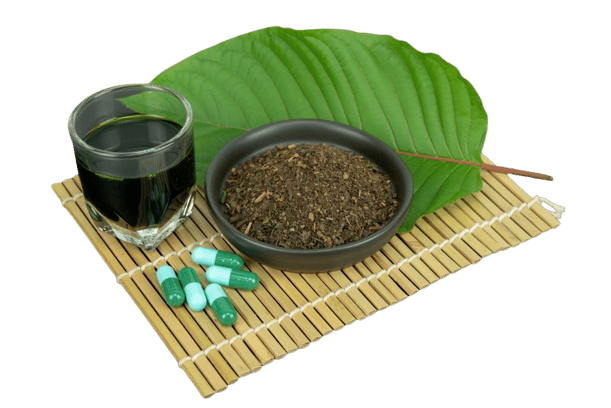
Thailand recently revoked its ban, and kratom is now one of the countries major economic exports.
Countries in Asia & The Pacific Where Kratom is Banned
- Australia
- Japan
- Malaysia
- Myanmar
- New Zealand
- Singapore
- South Korea
- Vietnam
How Does Kratom Work?
There are well over a dozen active ingredients in kratom — each one contributing a separate set of effects. Some activate the opioid receptors to block pain signals from reaching the brain — others target different neurotransmitters or receptors such as dopamine, serotonin, or glutamate.
The overall impact of this plant comes from the combined impact of all these different chemicals.
How kratom works:
- Activates mu-opioid receptor — blocks pain transmission & induces a euphoric sensation
- Blocks alpha-1 & alpha-2 adrenergic receptors — lowers blood pressure
- Activates 5-HT2A serotonin receptors — mild psychoactive effects
Kratom Active Ingredients
Most of the active ingredients in kratom are alkaloids — which are compounds that contain a nitrogen atom. Alkaloids are notorious for their ability to interact with human physiology.
Many of the most powerful compounds and drugs used today are alkaloids. Just a few examples include caffeine, cocaine, morphine, nicotine, and ephedrine.
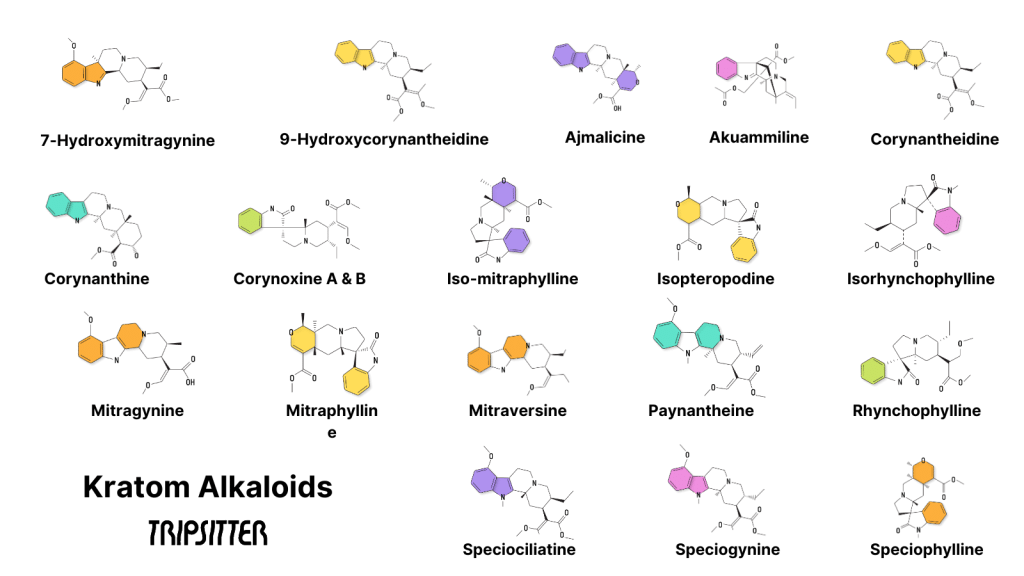
In kratom, there are dozens of different alkaloids (mostly indole and oxindole alkaloids). However, just four compounds make up about 90% of the alkaloid content in the plant — mitragynine, paynantheine, speciogynine, and 7-hydroxymitragynine.
The alkaloid content of kratom varies from one plant to another. Factors such as the strain, soil and growing conditions, and processing techniques used after harvest can all impact the alkaloid ratio of the final product. Differences in alkaloid ratios can affect the overall effect profile of the plant — which is why not all kratom feels the same.
1. 7-Hydroxymitragynine
This alkaloid acts on the mu-opioid receptors, giving it potent painkilling and cough-suppressant benefits. It’s especially abundant in red-vein kratom strains [1].
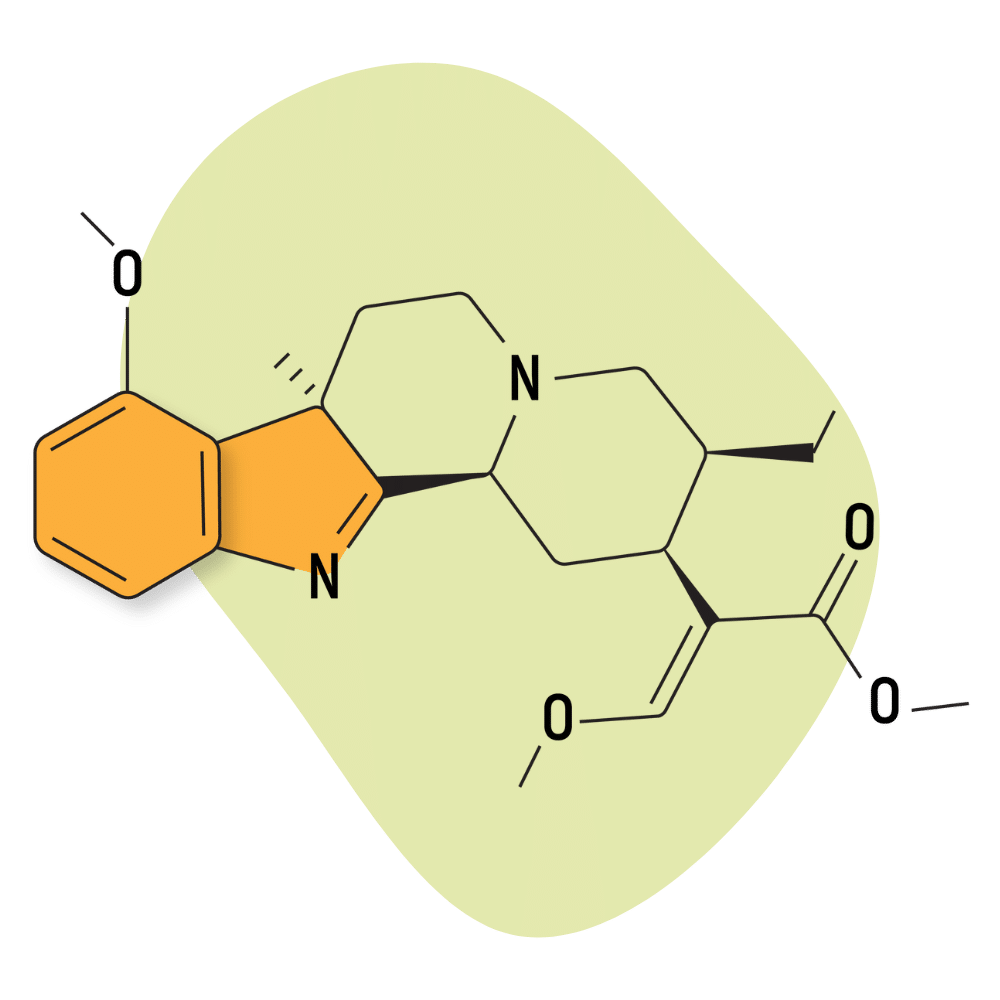
2. 9-Hydroxycorynantheidine
This alkaloid is only a partial opioid receptor agonist — which makes it much less potent than other kratom alkaloids. Some studies suggest this compound works to enhance the effects of other alkaloids in the plant.
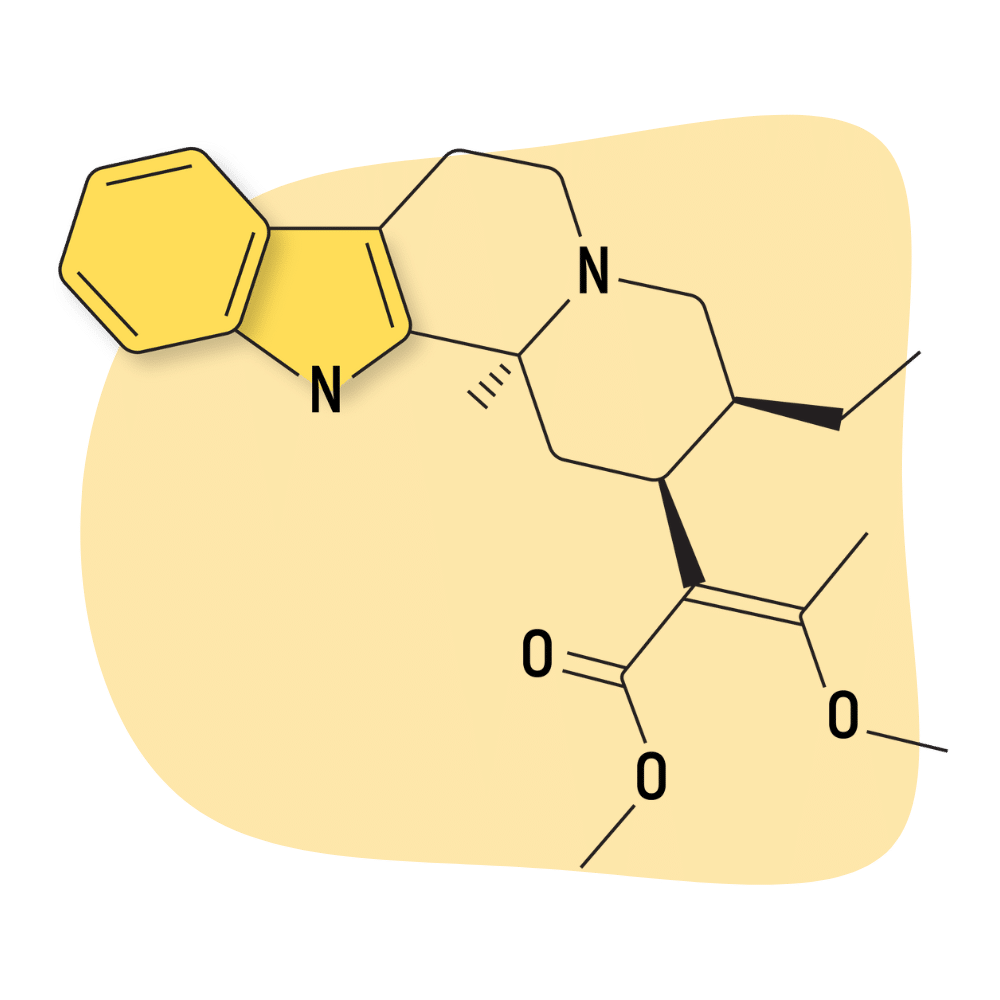
3. Ajmalicine
This compound is well-known for its presence in another stimulating herb called Yohimbe, where it is usually referred to as δ-yohimbine.
Ajmalicine works primarily through the α-1 adrenergic receptor. It blocks the effects of this receptor, causing smooth muscles in the arterial system to relax. Synthetic versions of this compound are currently under development as a potential treatment for high blood pressure and erectile dysfunction.
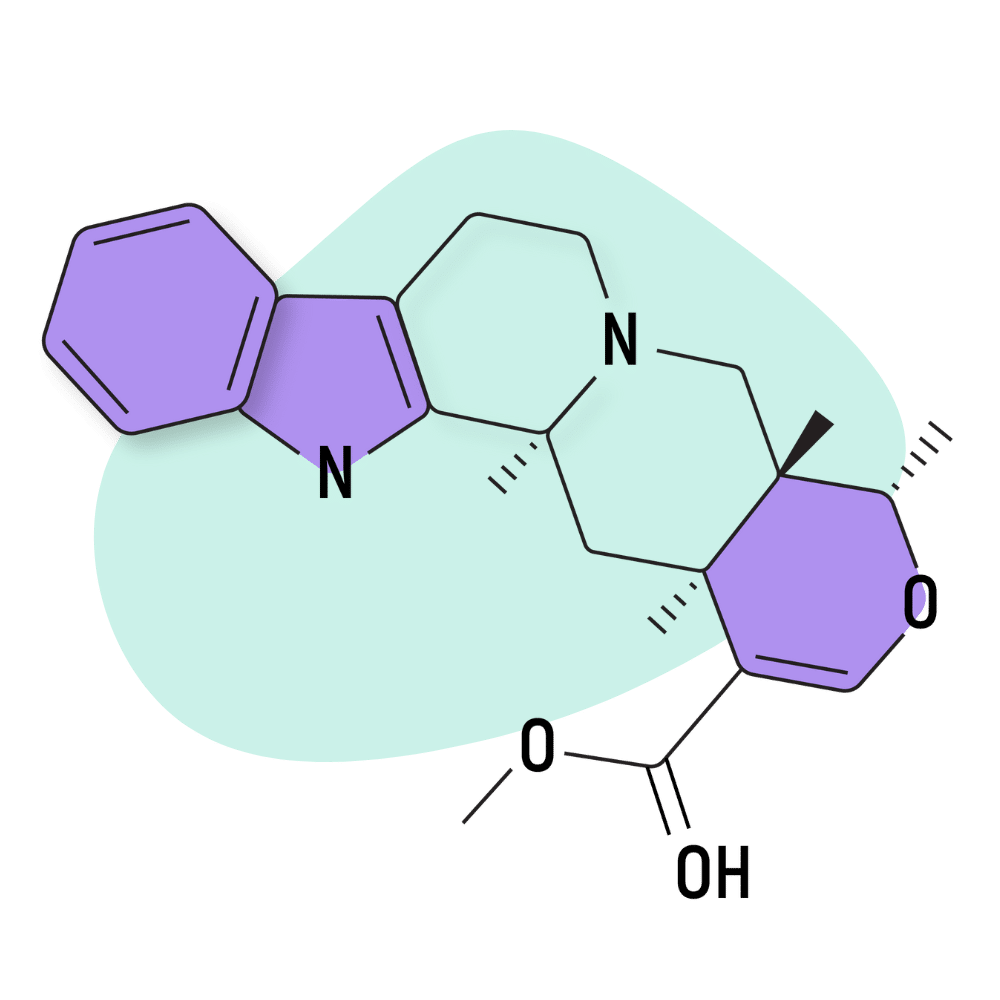
4. Akuammiline
Akuammiline is an indole alkaloid most prevalent in a herb called akuamma (Picralima nitida) — hence the name.
The specific effects of this compound are still under investigation, but it’s thought to have a similar profile to ajmalicine and mitragynine due to close similarities in chemical structure. This means the effects would be mild to moderate sedative and hypotensive.
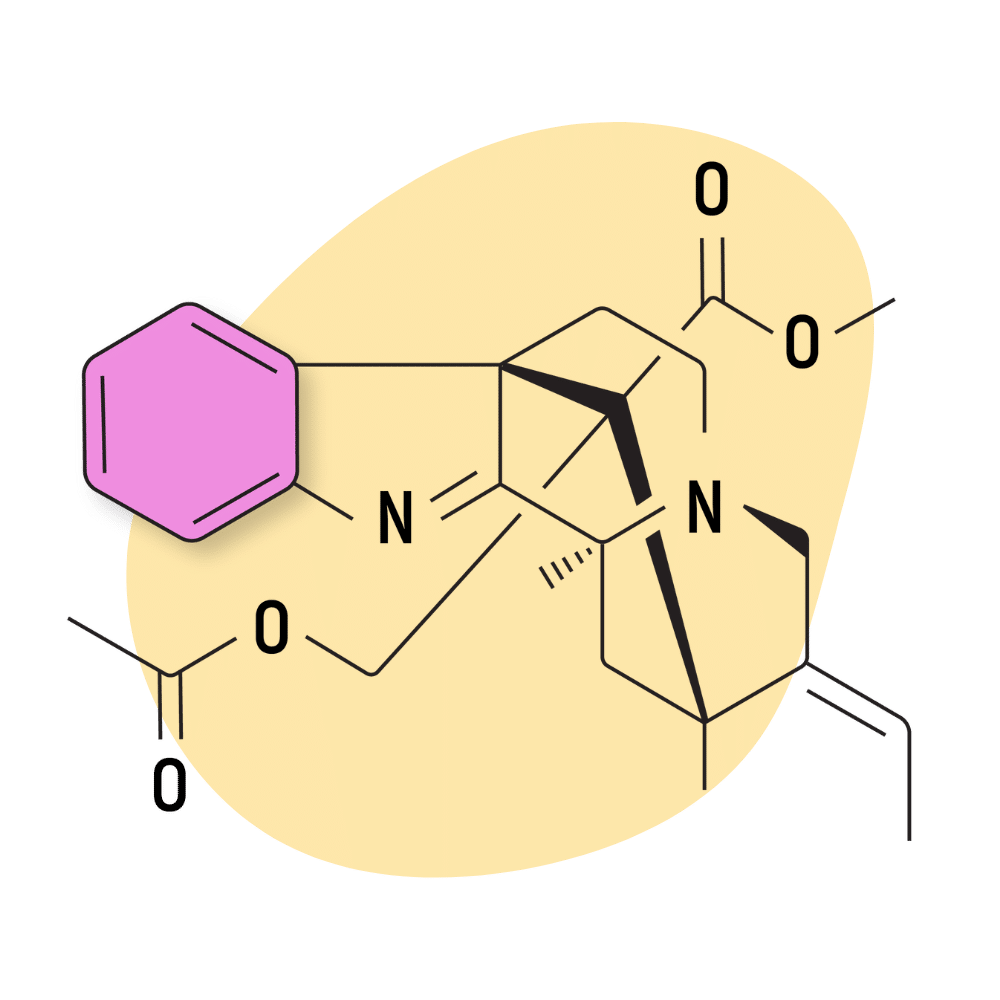
5. Ciliaphylline
This compound is present in low concentrations in the kratom plant, and there isn’t much research available on its effects. It’s thought to be an antitussive (cough suppressant) and analgesic (painkiller).
6. Corynantheidine
Corynantheidine works against most of the other alkaloids in the kratom plant. Instead of activating the opioid receptors, it blocks them. It’s also an α2-adrenergic receptor inhibitor — which gives it a subtle relaxing, sedative, and hypotensive effect profile.
This is another one of the shared alkaloids present in both kratom and Yohimbe.
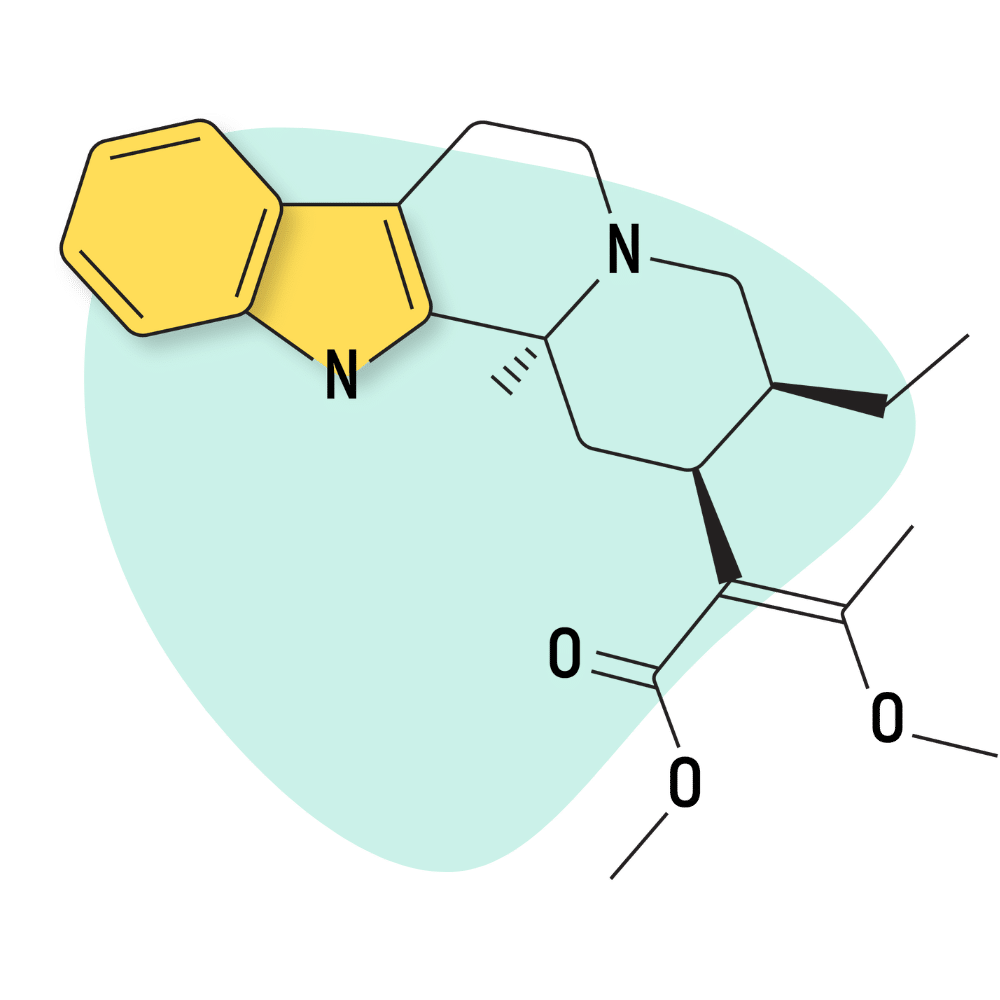
7. Corynanthine
Corynanthine is poorly understood — however, some preliminary studies suggest it acts as a calcium-channel blocker. This gives it a hypotensive effect profile unique from most of the other compounds produced in the kratom plant.
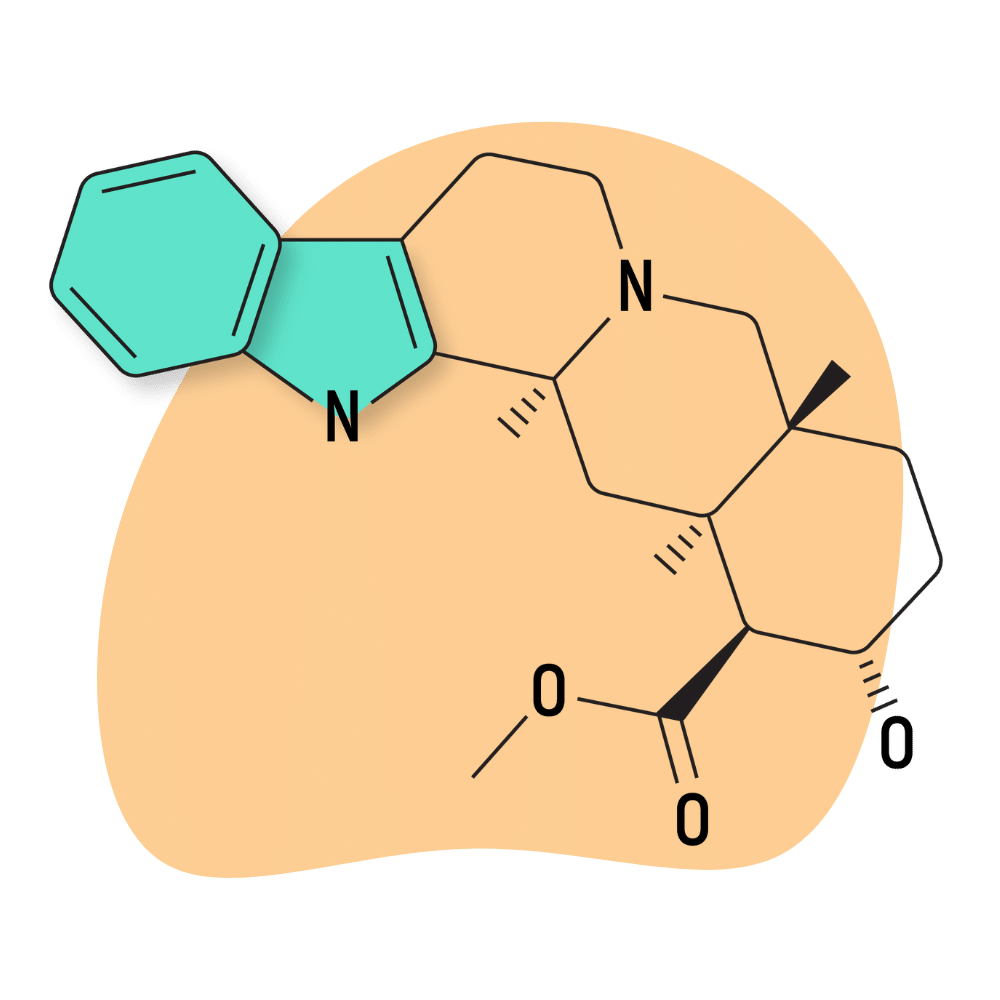
8. Corynoxine A & B
Two closely related compounds — Corynoxine A and Corynoxine B — both share almost identical effect profiles. They’ve been shown to offer neuroprotective effects through an interaction with dopamine receptors in the brain. They’re both thought to offer mild sedative action as well.
Corynoxine A is found in another medicinal herb called cat’s claw (Uncaria tomentosa) — which is renowned for its powerful protective action on the neurological system.
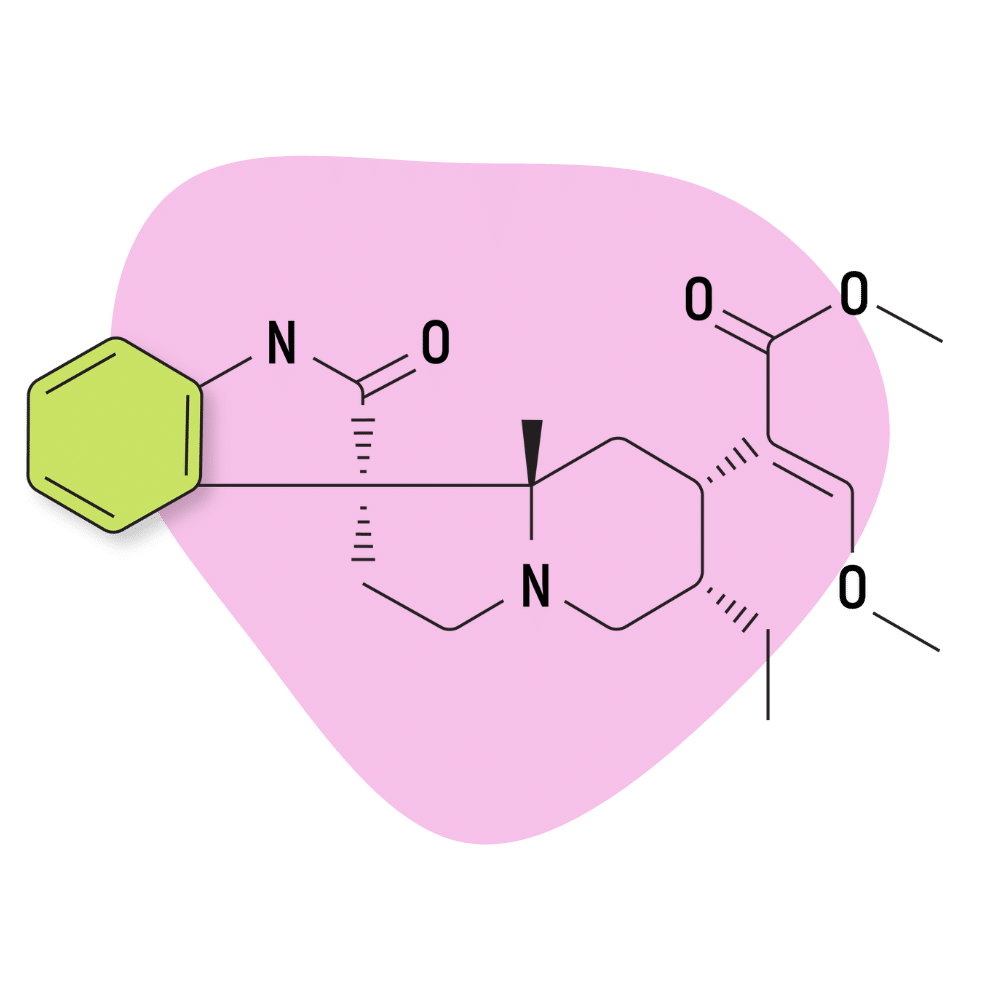
9. Iso-Mitraphylline
This alkaloid is an isomer of mitraphylline and shares a similar effect profile. It’s present in much smaller concentrations (less than 1%).
Some studies suggest this compound accounts for the majority of the immunostimulant effects of kratom despite its low concentrations.
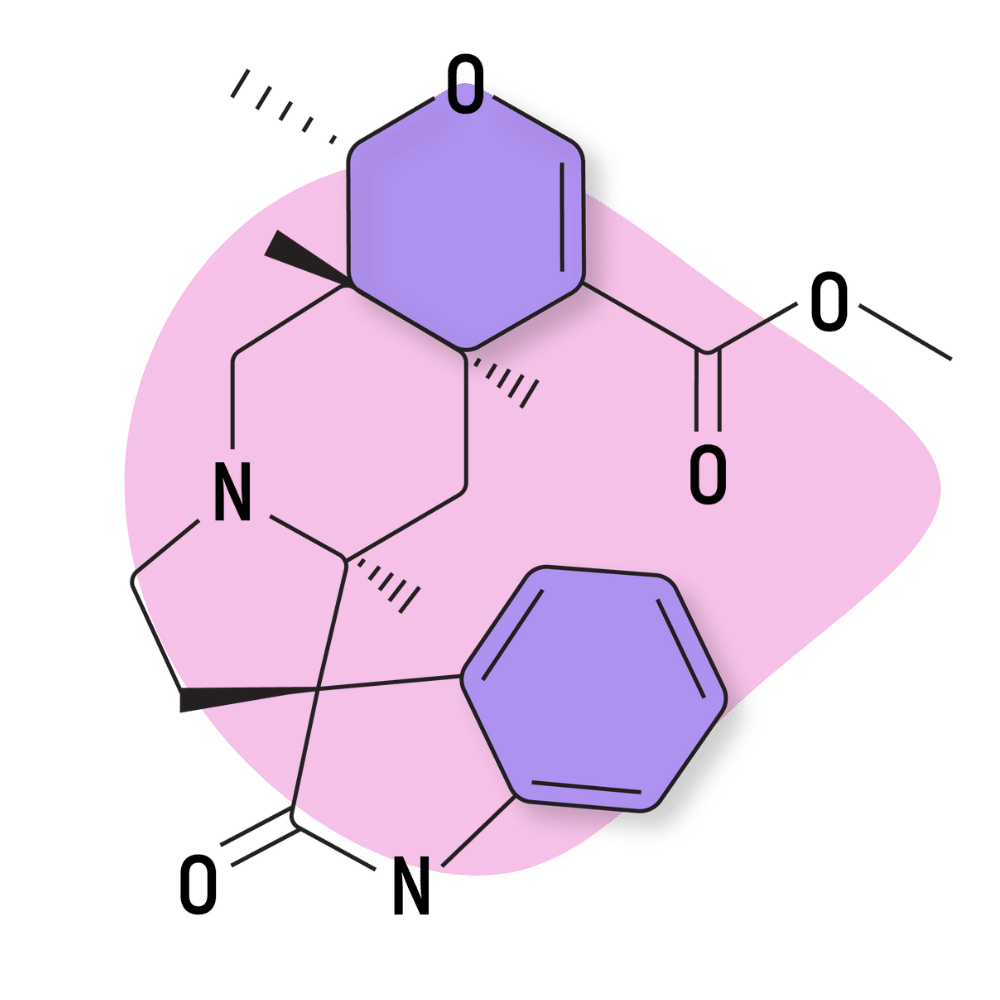
10. Isopteropodine
Isopteropodine has been shown to stimulate immune activity through similar mechanisms as iso mitraphylline. It’s also a 5-HTP serotonin receptor modulator, which gives its mood-supportive benefits.
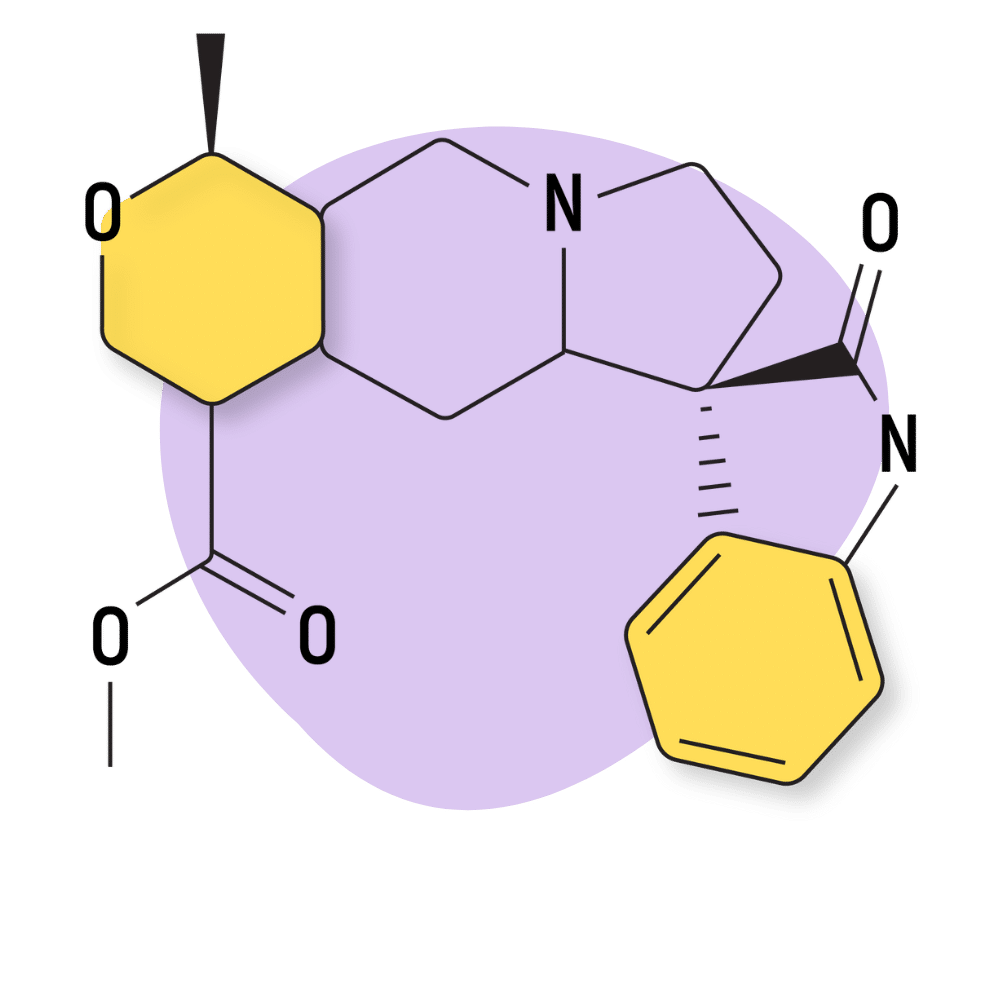
11. Isorhynchophylline
This alkaloid is also found in the Asian cat’s claw (Uncaria rhynchophylla). It’s been shown to provide immunostimulating and calcium-channel blocking activity [2].
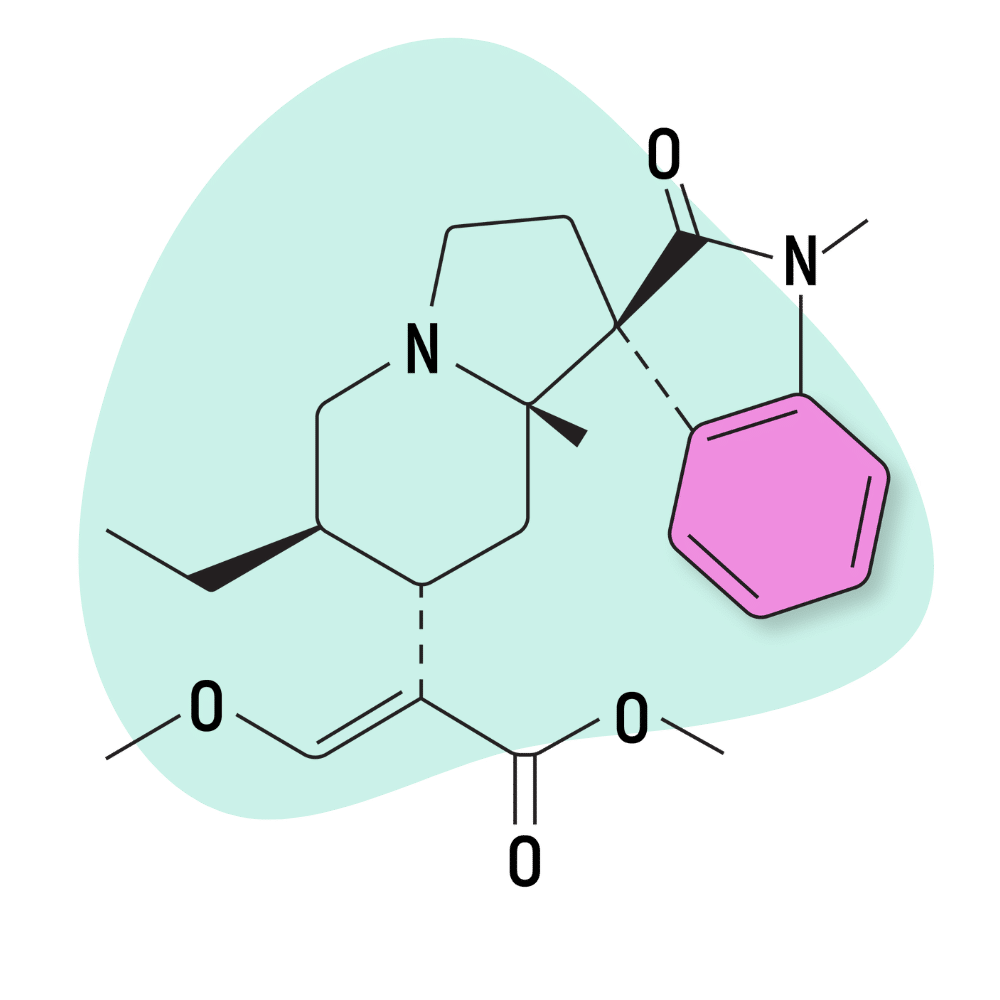
12. Mitragynine
This is the primary alkaloid in the kratom plant. It makes up approximately 66% of the total alkaloid content of the plant. Because of the high prevalence, there’s been a lot of research on the effects of this compound.
Mitragynine is a potent opioid receptor agonist, adrenergic receptor agonist, and 5HT2A receptor agonist (mild). The 5HT2A receptors are the primary target of many psychedelics — however, kratom has very low psychoactive effects and likely only has mild activity at the 5HT2A receptor sites.
This compound has been shown to reduce pain transmission, reduce the urge to be caught, alleviate diarrhea, and exert both stimulating and sedative effects (dose-dependent).
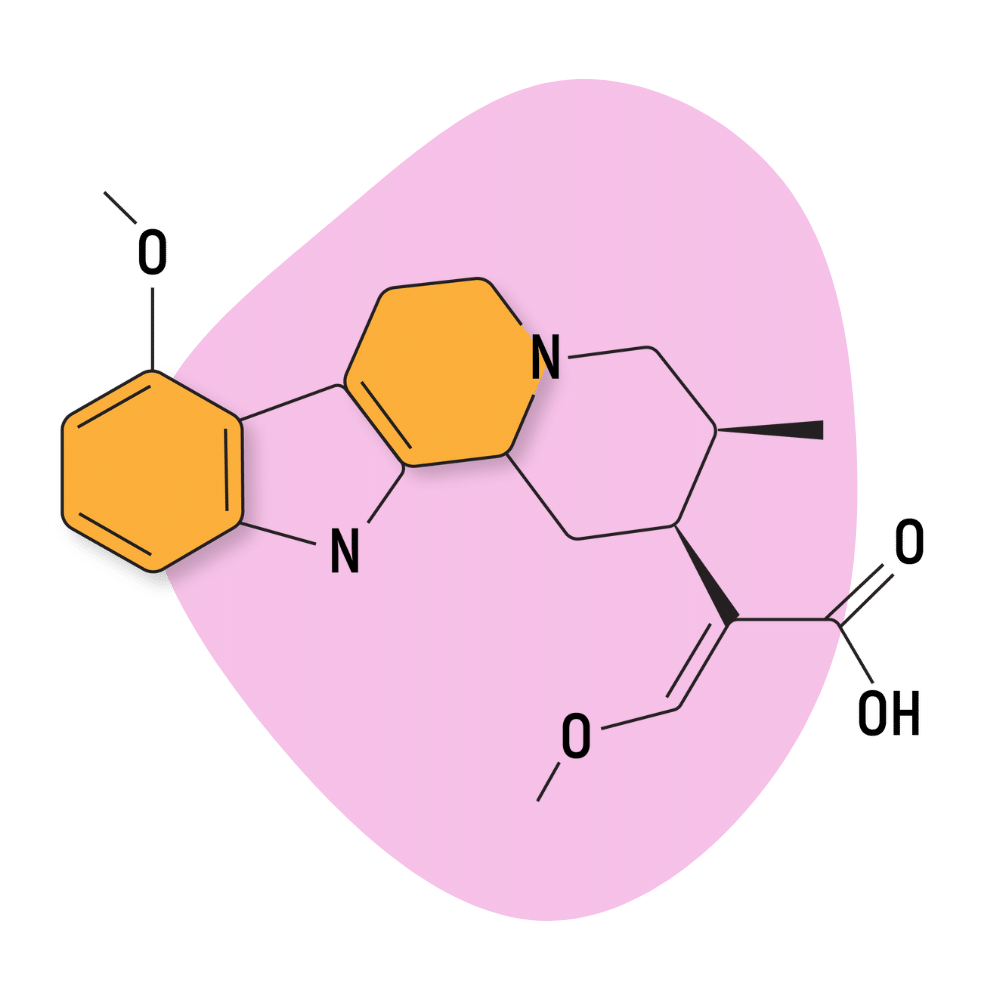
13. Mitraphylline
This compound is classified as an oxindole alkaloid. Its primary effects are vasodilating (reduced blood pressure), muscle relaxant, and diuretic (increases urine output).
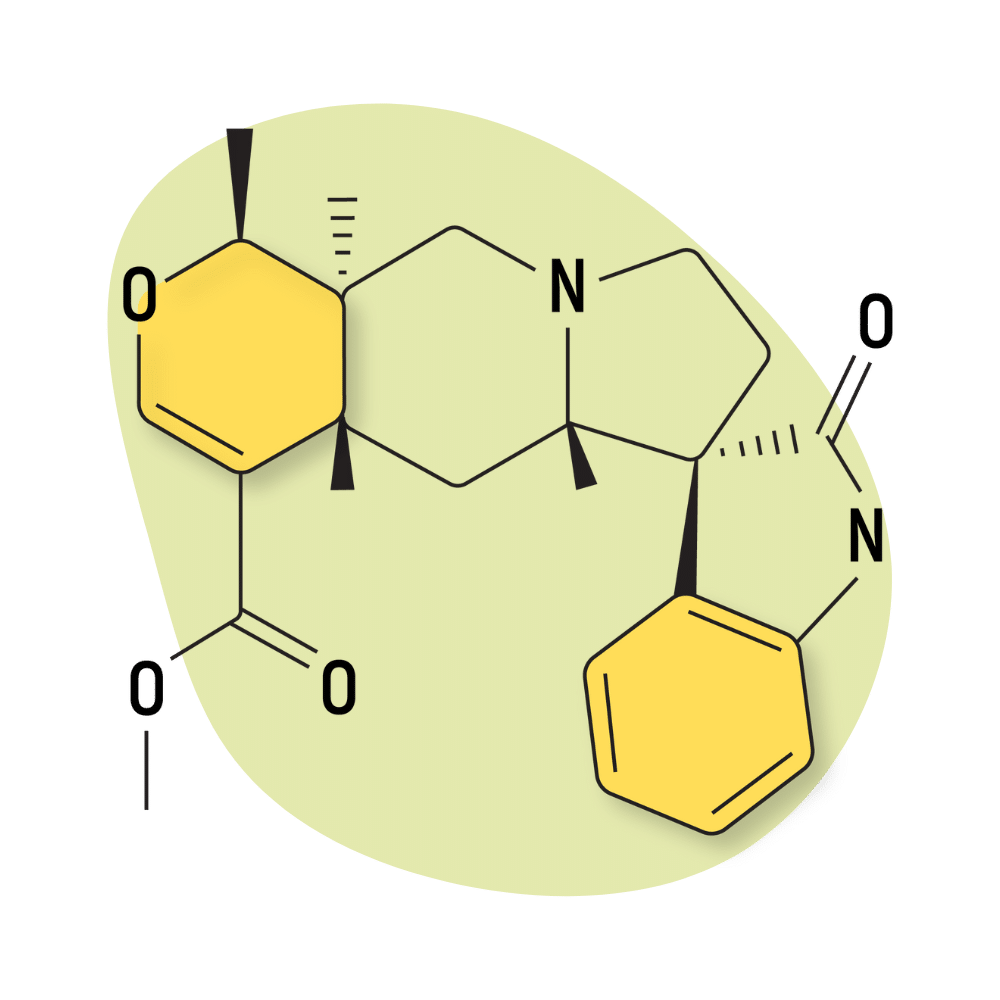
14. Mitraversine
This alkaloid is present in low concentrations in some kratoms strains — but it’s much more abundant in a related species called Mitragyna parvifolia.
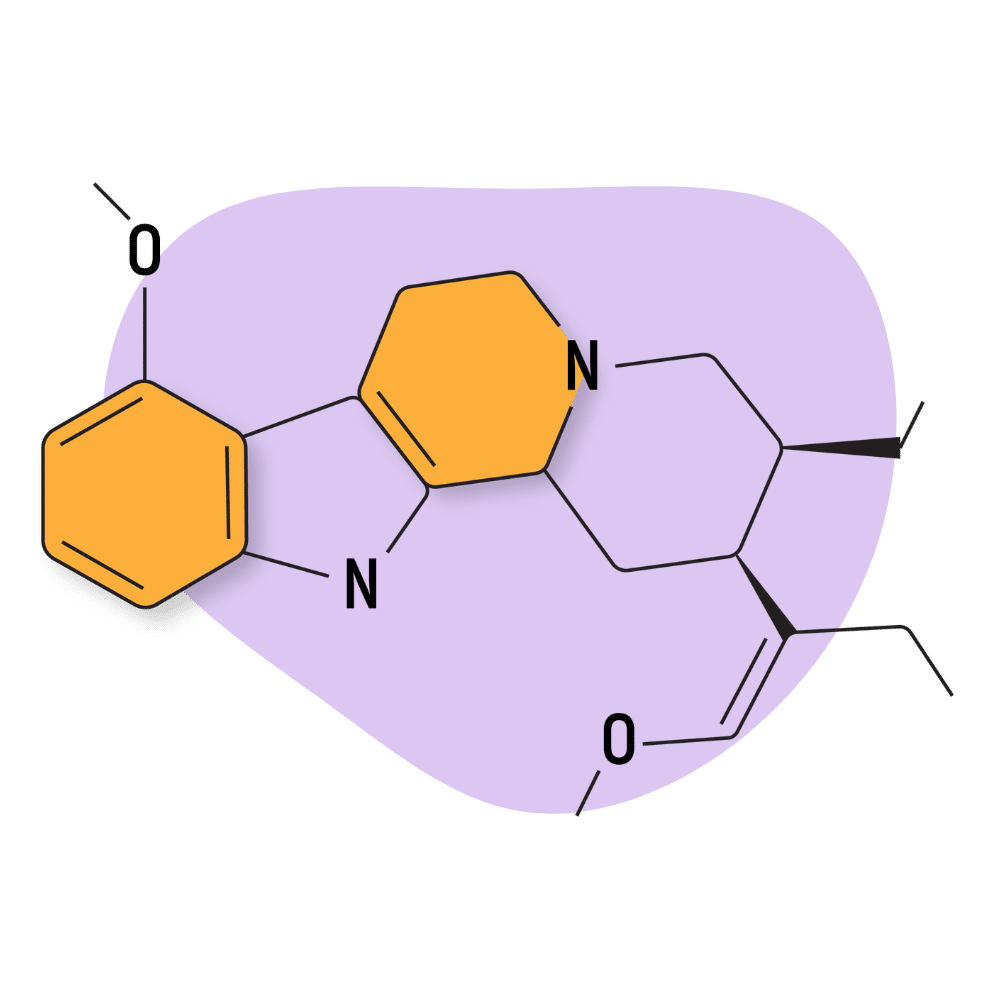
15. Paynantheine
This is the second most abundant compound in most kratom samples. It’s been shown to act as a smooth muscle relaxant and opioid receptor agonist. Some studies have also suggested this compound acts on the adrenergic receptors — giving it mild relaxing effects.
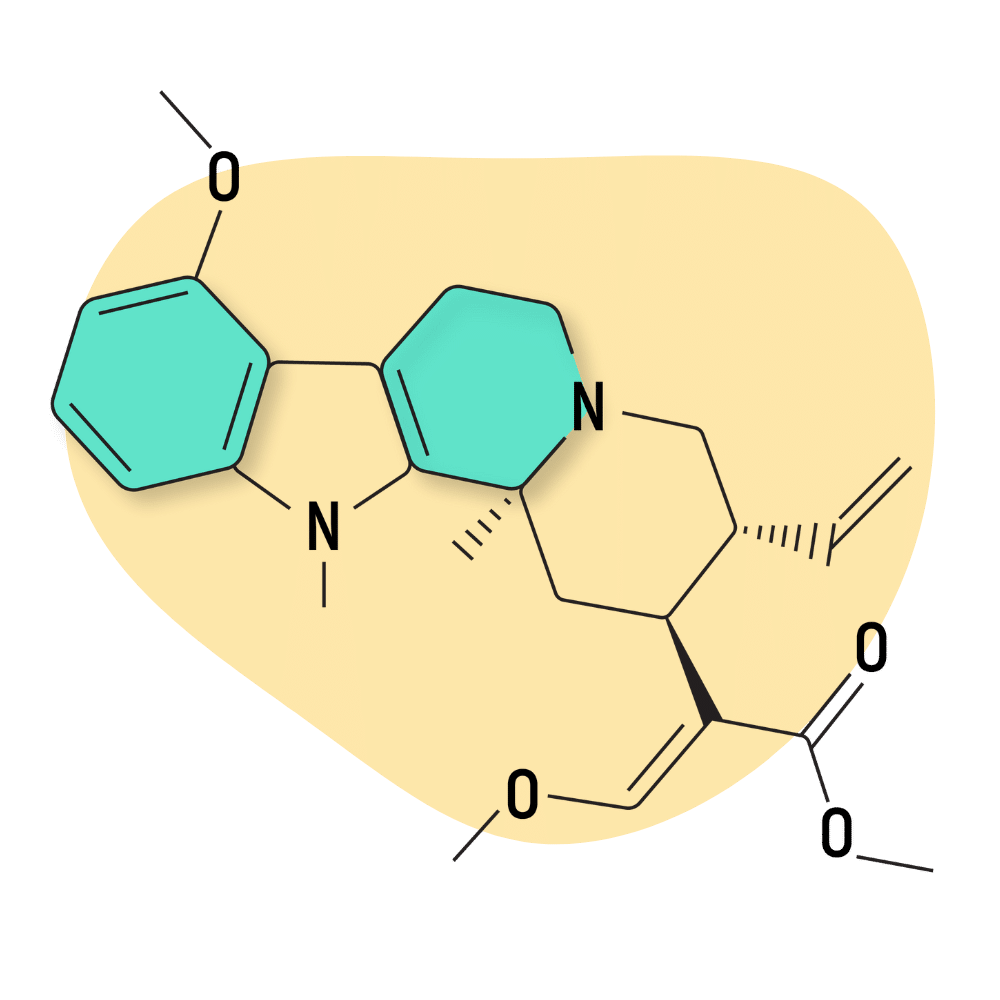
16. Rhynchophylline
Rhynchophylline is abundant in both kratom and Chinese cat’s claw. It’s currently being explored as a new antihypertensive medication because it’s been shown to reduce blood pressure without affecting blood flow in the kidneys — which is a major side effect of modern blood pressure medications.
Other studies have shown this compound offers anti-inflammatory, NMDA agonist, dopaminergic, serotonergic, and calcium channel-blocking activity.
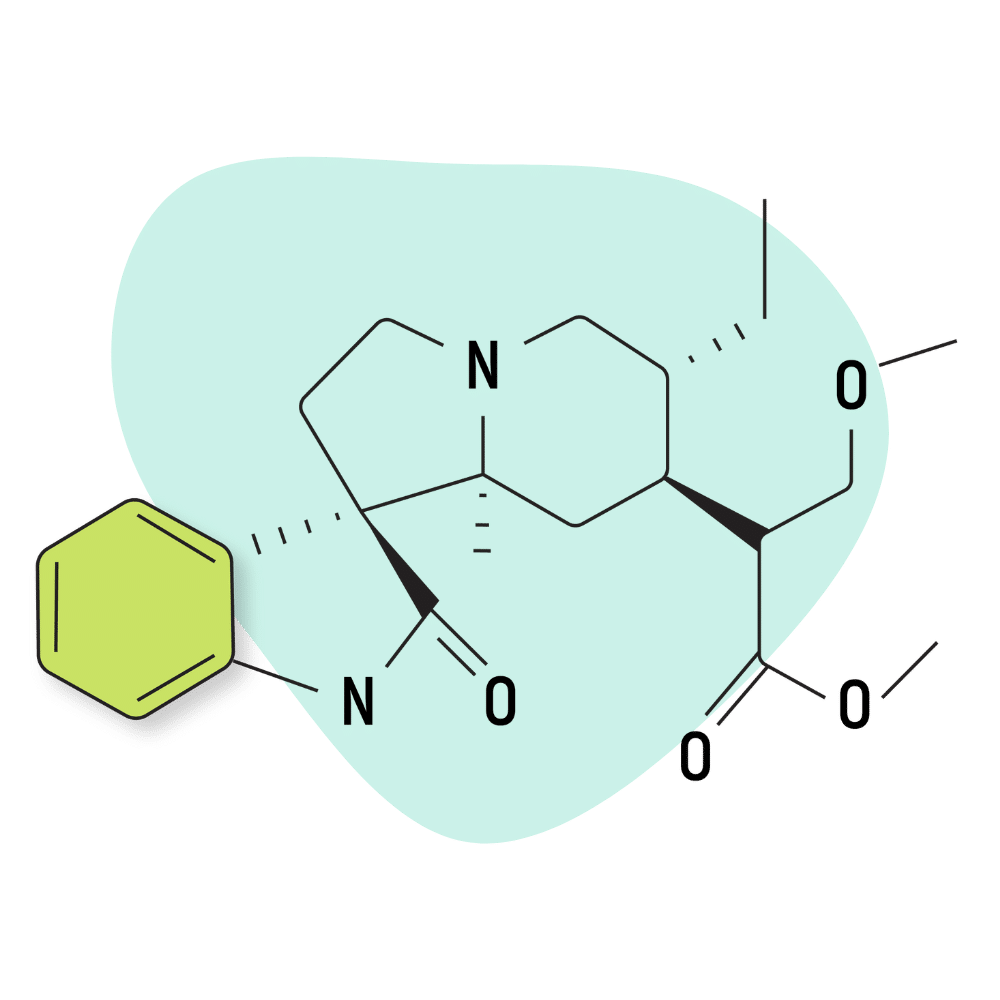
17. Speciociliatine
This compound is structurally very similar to mitragynine and possesses a similar set of effects — only much weaker. Some early studies suggest it may inhibit the release of acetylcholine in the brain — but more research is needed to confirm.
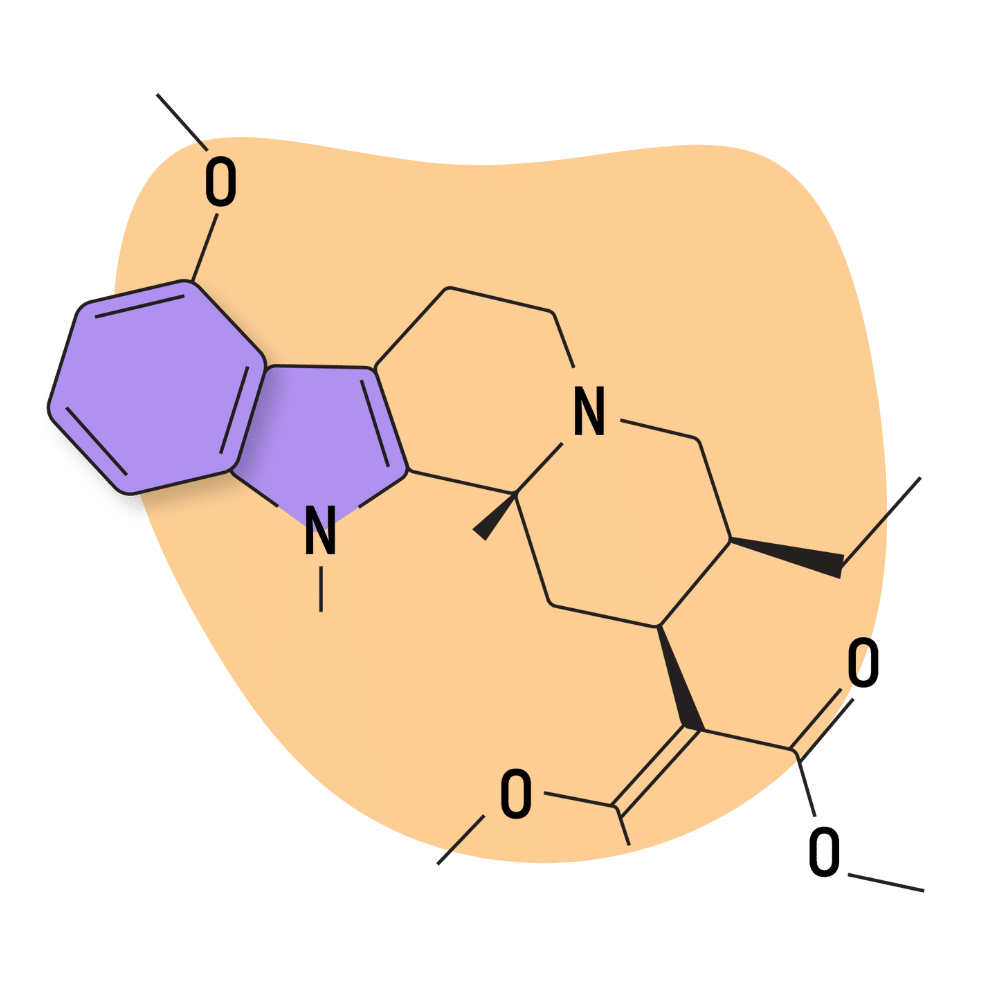
18. Speciogynine
Speciogynine is the third most abundant alkaloid in the plant. It’s been shown to provide muscle-relaxant and anxiolytic effects. Some sources suggest this compound works to directly reduce some of the key side effects of the more stimulating compounds in the kratom plant.
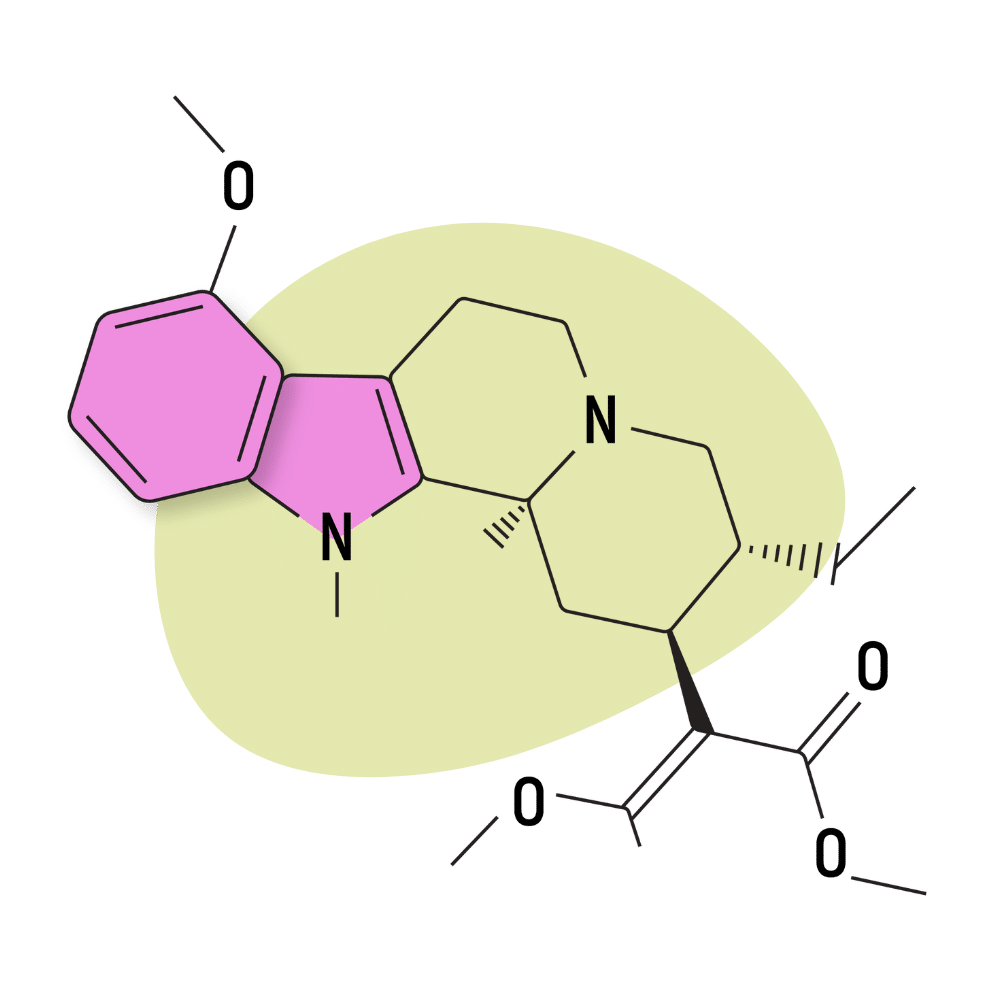
19. Speciophylline
Seciophylline is one of the several alkaloids shared by both kratom and the Chinese cat’s claw plant. Unfortunately, there isn’t much research available for this compound due to its low concentration in both species of plants.
Some of the preliminary research on this compound derived from the cat’s claw plant suggests it may offer a protective action against leukemia cancer cell lines.
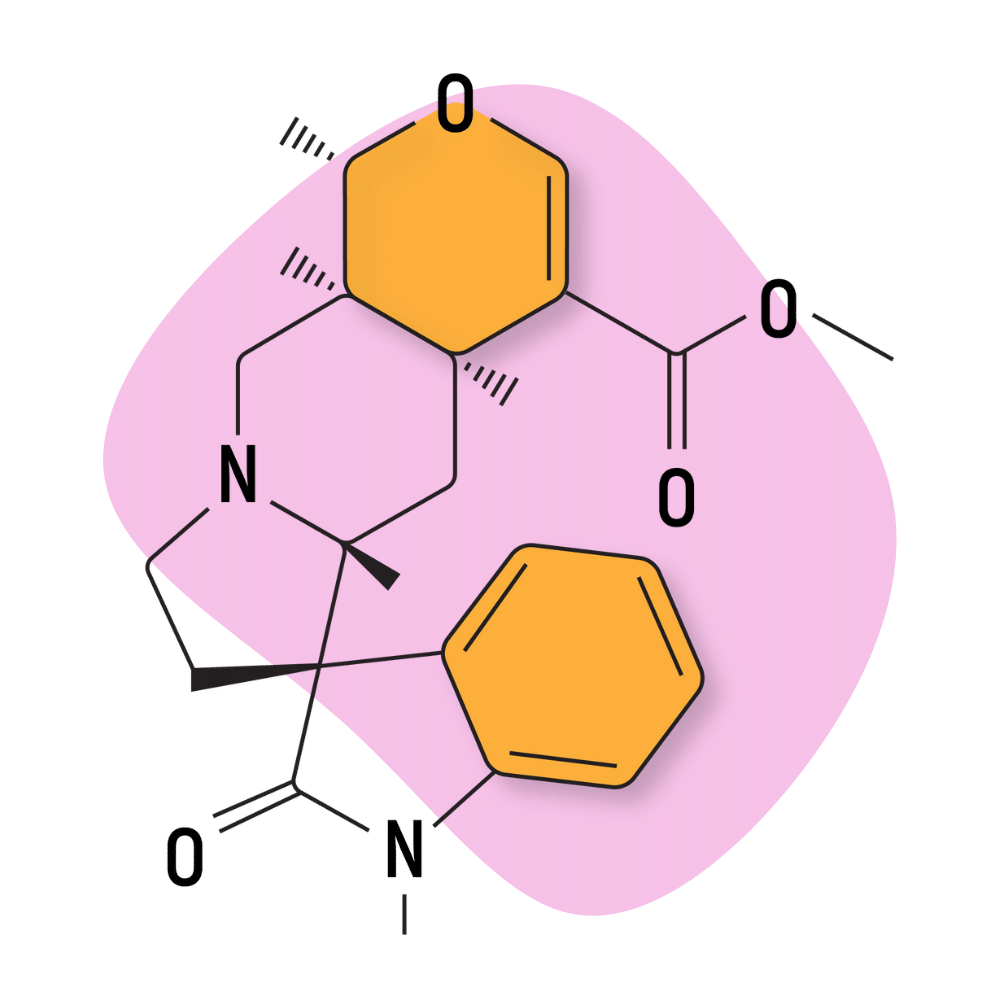
20. Epicatechin
Epicatechin is not an alkaloid — it’s a flavonoid with potent antioxidant action also found in the tea plant (Camellia sinensis), chocolate (Theobroma cacao), and grapevine (Vitis vinifera).
This compound is well-studied for its ability to reduce oxidative damage and protect the lungs, skin, and cardiovascular system from the harmful effects of free radicals and heavy metals.
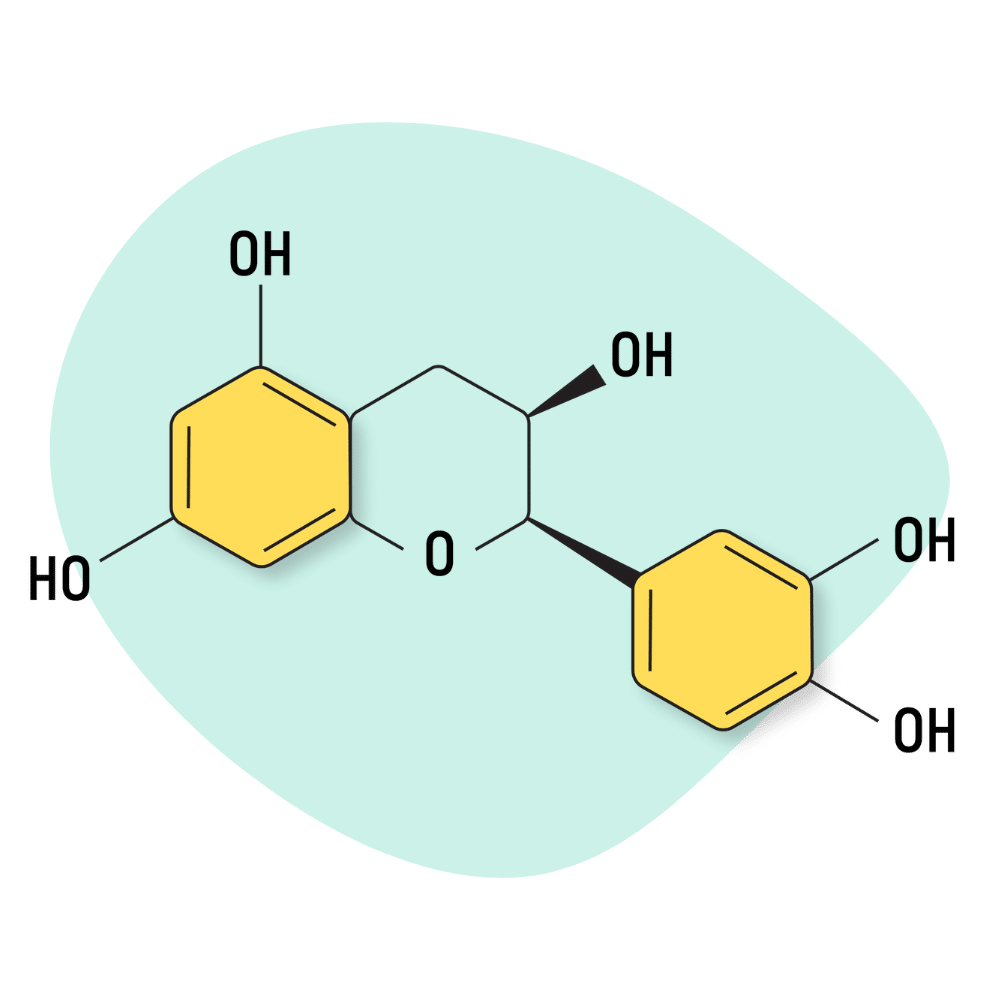
21. Daucosterol
This is another one of the primary non-alkaloid ingredients in the kratom plant. Chemically this compound is classified as a saponin. It’s thought to be one of the primary ingredients in kratom that provide the immune-boosting benefit of the plant.
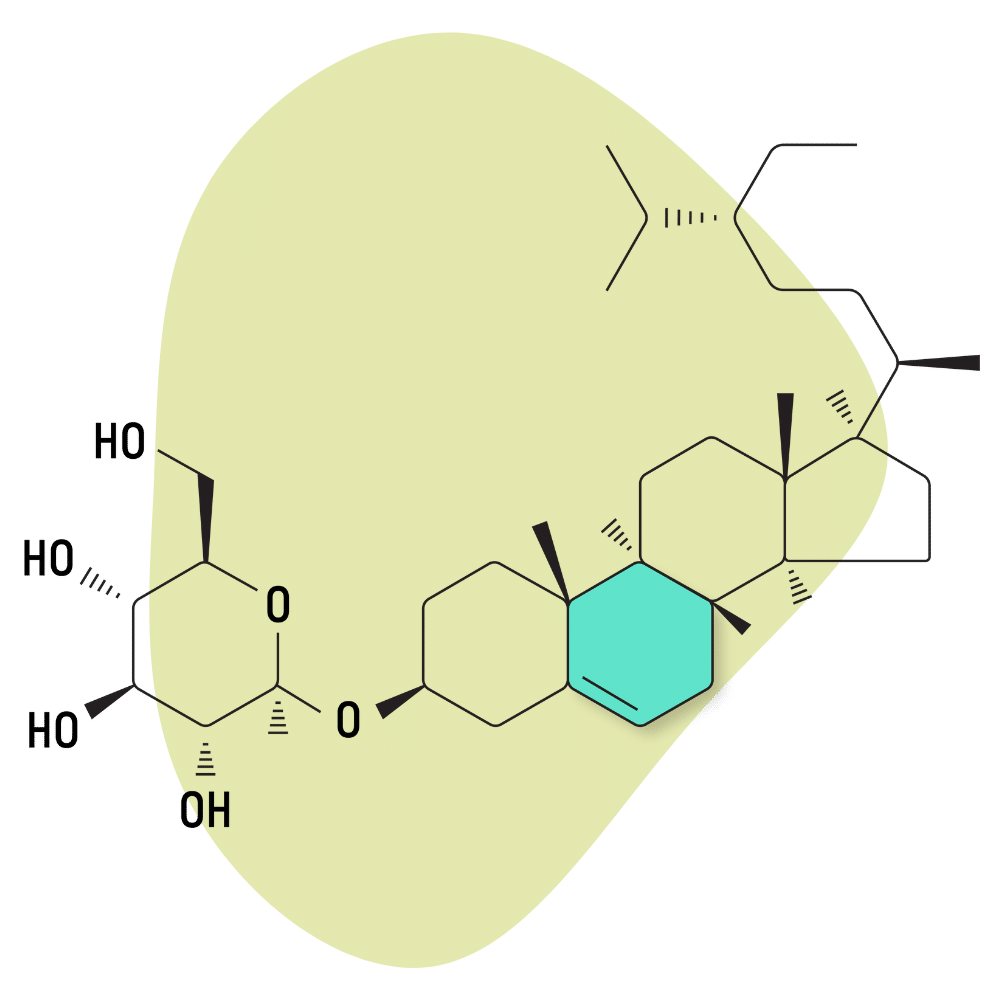
Key Takeaways: Kratom
Kratom is a psychoactive plant from Southeast Asia. It’s used in lower doses for its stimulating effects — very similar to coffee. In higher doses, the effects of the plant are much more sedative, euphoric, and analgesic.
The most popular use of this herb is for its stimulating or nootropic effects, but many people are also using it to relieve chronic pain or improve mood.
Alkaloids in the kratom plant bind to the opiate receptors, which makes them especially useful for managing pain and can also be used to relieve withdrawal symptoms from opiate drugs.
Kratom can also be used for its psychoactive effects as an alternative to prescription pain medications or alcohol — however, due to the potential for addiction to this herb, this is not recommended. It’s also not safe to mix kratom with alcohol or any other medications.
Subscribe To Get a Weekly Dose of Psychedelics In Your Inbox 🌈 📩 🍄 💫
References
- Ponglux, D., Wongseripipatana, S., Takayama, H., Kikuchi, M., Kurihara, M., Kitajima, M., … & Sakai, S. I. (1994). A new indole alkaloid, 7 α-hydroxy-7H-mitragynine, from Mitragyna speciosa in Thailand. Planta medica, 60(06), 580-581.
- Shi, J. S., Yu, J. X., Chen, X. P., & Xu, R. X. (2003). Pharmacological actions of Uncaria alkaloids, rhynchophylline, and isorhynchophylline. Acta Pharmacologica Sinica, 24(2), 97-101.
- Azadfard, M., Huecker, M. R., & Leaming, J. M. (2020). Opioid Addiction. Treasure Island, FL: StatPearls.
- Macko, E., Weisbach, J. A., & Douglas, B. (1972). Some observations on the pharmacology of mitragynine. Archives internationales de pharmacodynamie et de thérapie, 198(1), 145.
- Suwanlert, S. (1975). A study of kratom eaters in Thailand. Bull Narc, 27(3), 21-27.
- Hassan, Z., Muzaimi, M., Navaratnam, V., Yusoff, N. H., Suhaimi, F. W., Vadivelu, R., … & Jayabalan, N. (2013). From Kratom to mitragynine and its derivatives: physiological and behavioral effects related to use, abuse, and addiction. Neuroscience & Biobehavioral Reviews, 37(2), 138-151.
- Jansen, K. L., & Prast, C. J. (1988). Psychoactive properties of mitragynine (kratom). Journal of psychoactive drugs, 20(4), 455-457.
- Khor, B. S., Jamil, M. F. A., Adenan, M. I., & Shu-Chien, A. C. (2011). Mitragynine attenuates withdrawal syndrome in morphine-withdrawn zebrafish. PLoS One, 6(12), e28340.
- Mossadeq, W. S., Sulaiman, M. R., Mohamad, T. T., Chiong, H. S., Zakaria, Z. A., Jabit, M. L., … & Israf, D. A. (2009). Anti-inflammatory and antinociceptive effects of Mitragyna speciosa Korth methanolic extract. Medical Principles and Practice, 18(5), 378-384.
- Hassan, Z., Muzaimi, M., Navaratnam, V., Yusoff, N. H., Suhaimi, F. W., Vadivelu, R., … & Jayabalan, N. (2013). From Kratom to mitragynine and its derivatives: physiological and behavioral effects related to use, abuse, and addiction. Neuroscience & Biobehavioral Reviews, 37(2), 138-151.
- Matsumoto, K., Mizowaki, M., Suchitra, T., Murakami, Y., Takayama, H., Sakai, S. I., … & Watanabe, H. (1996). Central antinociceptive effects of mitragynine in mice: contribution of descending noradrenergic and serotonergic systems. European Journal of Pharmacology, 317(1), 75-81.
- Klitenick, M. A., DeWitte, P., & Kalivas, P. W. (1992). Regulation of somatodendritic dopamine release in the ventral tegmental area by opioids and GABA: an in vivo microdialysis study. Journal of Neuroscience, 12(7), 2623-2632.
- Sasaki, K., Fan, L. W., Tien, L. T., Ma, T., Loh, H. H., & Ho, K. (2002). The interaction of morphine and γ-aminobutyric acid (GABA) ergic systems in anxiolytic behavior: using μ-opioid receptor knockout mice. Brain research bulletin, 57(5), 689-694.

